Analysis of Ten-Year Variations of Lightning Activity in Italy and Correlation with Land and Sea Surface Temperatures
Abstract
1. Introduction
2. Lightning Data
- Seasonal maps and monthly variation in GSD;
- Monthly variation in the negative-to-positive cloud-to-ground stroke ratio;
- Diurnal cycle lighting occurrence across different seasons;
- Seasonal distributions of strike-point elevation and its dependence on latitude;
- Monthly variation in the mean peak current at the channel base;
- Distribution of flash multiplicity and the spatial separation between stroke impact points within a flash;
- Distribution of the current peak for positive first strokes, negative first strokes, and negative subsequent strokes.
3. Lightning Activity: Results and Discussion
3.1. Seasonal Maps of CG Strokes
3.2. Monthly Variation in CG Stroke Density
3.3. Monthly Variation in the Negative/Positive CG Strokes Ratio
3.4. Seasonal Diurnal Cycle Distributions
3.5. Seasonal Distribution of the Point of Impact Elevation and Its Latitude Dependence
3.6. Monthly Variation in the Peak Current
3.7. Distribution of Flash Multiplicity and of the Distance Between the Stroke Points of Impact Within a Flash
3.8. Distribution of the Peak Current for Positive First Strokes, Negative First Strokes, and Negative Subsequent Strokes
4. Correlation of Lightning Occurrence with Land and Sea Surface Temperatures
5. Conclusions
- A significant seasonal variability in lightning activity is highlighted in both periods and between them. In general, the highest number of total strokes is recorded in summer and in autumn, while the lowest ones are in winter and in spring. A remarkable increase in the lightning activity in Italy has occurred in 2020–2021 with respect to 2010–2011 (+24%, +83%, and +29% for negative, positive, and total strokes, respectively). Summer and winter total strokes are comparable, but strong differences appear in spring (−47%) and autumn (+58%).
- The monthly mean density has a similar trend in both 2010–2011 and 2020–2021 periods. Positive events are much less than negative ones. CG stroke density in 2010–2011 reaches greater values over the land in summer, whereas in 2020–2021 the highest densities are over the sea during autumn. Regardless of the polarity, CG lightning activity is more relevant over the sea than land from October to January in 2010–2011 and for September to January in 2020–2021.
- The monthly negative/positive CG stroke ratio reaches lower values in 2020–2021 than in 2010–2011. In 2020–2021, the ratio between negative CG and positive CG strokes is almost always higher over the land than over the sea, whereas for 2010–2011, the opposite holds true.
- In each season the lightning activity is almost constant along the day over the sea, regardless of the polarity. For what concerns both negative and positive CG strokes over the land, the highest concentration occurs between the late morning and the afternoon (10-18 UTC) in each season, except in winter.
- The range of elevation variability at which lightning occurs is different among the three zones in which the Italian territory has been divided. The main difference between the two periods regards the distribution of the elevation of winter CG strokes: a significant increase in the 50% and 90% percentiles is detected in 2020–2021, except for positive events in North Italy in which the behavior is like that of 2010–2011. By comparing the South Italy distributions in the two periods, a remarkably higher seasonal variability appears during 2020–2021.
- Monthly mean positive peak currents recorded in 2020–2021 are lower to those of 2010–2011. For monthly mean negative peak current, no significant variability has been observed between the two biennia. In both periods, the higher negative peak currents are always recorded over the sea, whereas the positive values over the land are higher than those over the sea from July to December in 2010–2011 and always higher in 2020–2021. The trend is similar in the two periods and inverse with respect to the Ground Stroke Density.
- Both in the 2010–2011 period and the 2020–2021 period, the value of the mean positive flash multiplicity is lower than the corresponding negative one. Values in the two periods are comparable.
- As regards the distribution of the distance between the stroke points of impact within a flash, negative subsequent strokes are more concentrated around the first stroke impact point in 2020–2021 than in 2010–2011. On the other hand, positive flashes in 2010–2011 contain strokes with more uniform distribution than in 2020–2021, where more than circa 25% of subsequent strokes impact within 1 km from the corresponding first stroke.
- In both periods, the peak current median values for negative and positive first strokes are lower with respect to the measurements obtained by Berger and his co-workers, even though the median current values in 2010–2011 are much closer to the ground truth data than those of 2020–2021.
Author Contributions
Funding
Data Availability Statement
Acknowledgments
Conflicts of Interest
References
- Rakov, V.A.; Uman, M.A. Lightning: Physics and Effects; Cambridge University Press: Cambridge, UK, 2003. [Google Scholar]
- Carter, A.E.; Kidder, R.E. Lightning in relation to precipitation. J. Atmos. Terr. Phys. 1977, 39, 139–148. [Google Scholar] [CrossRef]
- Orville, R.E.; Henderson, R. Global distribution of midnight lightning: September 1977 to August 1978. Mon. Weather Rev. 1986, 14, 2640–2653. [Google Scholar] [CrossRef]
- Tapia, A.; Smith, J.A.; Dixon, M. Estimation of Convective Rainfall from Lightning Observations. J. Appl. Meteorol. 1998, 37, 1497–1509. [Google Scholar] [CrossRef]
- Soula, S.; Chauzy, S. Some aspects of the correlation between lightning and rain activities in thunderstorms. Atmos. Res. 2001, 56, 355–373. [Google Scholar] [CrossRef]
- Adamo, C.; Goodman, S.; Mugnai, A.; Weinman, J.A. Lightning Measurements from Satellites, Significance for Storms in the Mediterranean. In Lightning: Principles, Instruments and Applications: Review of Modern Lightning Research; Betz, H.D., Schumann, U., Laroche, P., Eds.; Springer: Dordrecht, The Netherlands, 2009; pp. 309–329. [Google Scholar]
- Price, C. Lightning data assimilation enhances thunderstorm prediction capability. Sci. Bull. 2025, 70, 2394–2396. [Google Scholar] [CrossRef]
- Liu, D.; Yu, H.; Sun, Z.; Zhang, H.; Wang, D. Convective Properties and Lightning Activity in Different Categories of Thunderstorms over the Beijing Area during Five Warm Seasons. Remote Sens. 2024, 16, 447. [Google Scholar] [CrossRef]
- Zhang, H.; Deng, Y.; Wang, Y.; Lan, L.; Wen, X.; Fang, C.; Xu, J. Extraction of Factors Strongly Correlated with Lightning Activity Based on Remote Sensing Information. Remote Sens. 2024, 16, 1921. [Google Scholar] [CrossRef]
- Jiang, S.; Lyu, F.; Cummer, S.A.; Zheng, T.; Wang, M.; Liu, Y.; Lyu, W. A Case Study on the Vertical Distribution and Correlation Between Low-Frequency Lightning Sources and Hydrometeors During a Thunderstorm. Remote Sens. 2025, 17, 2676. [Google Scholar] [CrossRef]
- Gofa, F.; Boucouvala, D.; Samos, I.; Louka, P. Lightning potential forecast evaluation and its correlation with thermodynamic indices. Environ. Sci. Proc. 2023, 26, 109. [Google Scholar] [CrossRef]
- Ma, R.; Zheng, D.; Zhang, Y.; Yao, W.; Zhang, W.; Zhu, B. Thunderstorms with Extreme Lightning Activity in China: Climatology, Synoptic Patterns, and Convective Parameters. Remote Sens. 2024, 16, 4673. [Google Scholar] [CrossRef]
- Sun, J.; Chai, J.; Leng, L.; Xu, G. Analysis of Lightning and Precipitation Activities in Three Severe Convective Events Based on Doppler Radar and Microwave Radiometer over the Central China Region. Atmosphere 2019, 10, 298. [Google Scholar] [CrossRef]
- Kastman, J.S.; Market, P.S.; Fox, N.I.; Foscato, A.L.; Lupo, A.R. Lightning and Rainfall Characteristics in Elevated vs. Surface Based Convection in the Midwest that Produce Heavy Rainfall. Atmosphere 2017, 8, 36. [Google Scholar] [CrossRef]
- Hu, J.; Rosenfeld, D.; Zrnic, D.; Williams, E.; Zhang, P.; Snyder, J.C.; Ryzhkov, A.; Hashimshoni, E.; Zhang, R.; Weitz, R. Tracking and characterization of convective cells through their maturation into stratiform storm elements using polarimetric radar and lightning detection. Atmos. Res. 2019, 226, 192–207. [Google Scholar] [CrossRef]
- Price, C.G. Lightning Applications in Weather and Climate Research. Surv. Geophys. 2013, 34, 755–767. [Google Scholar] [CrossRef]
- Taszarek, M.; Allen, J.T.; Groenemeijer, P.; Edwards, R.; Brooks, H.E.; Chmielewski, V.; Enno, S.E. Severe convective storms across Europe and the United States. Part 1: Climatology of lightning, large hail, severe wind and tornadoes. J. Clim. 2020, 33, 10239–10261. [Google Scholar] [CrossRef]
- Taszarek, M.; Brooks, H.E.; Czernecki, B.; Szuster, P.; Fortuniak, K. Climatological Aspects of Convective Parameters over Europe: A Comparison of ERA-Interim and Sounding Data. J. Clim. 2018, 31, 4281–4308. [Google Scholar] [CrossRef]
- Yair, Y.; Lynn, B.; Price, C.; Kotroni, V.; Lagouvardos, K.; Morin, E.; Mugnai, A.; Llasat, M.d.C. Predicting the potential for lightning activity in Mediterranean storms based on the Weather Research and Forecasting (WRF) model dynamic and microphysical fields. J. Geophys. Res. Atmos. 2010, 115, D04205. [Google Scholar] [CrossRef]
- La Fata, A.; Moser, G.; Procopio, R.; Bernardi, M.; Fiori, E. A Gaussian process regression method to nowcast cloud-to-ground lightning from remote sensing and numerical weather modeling data. IEEE J. Sel. Top. Appl. Earth Obs. Remote Sens. 2025, 18, 1963–1981. [Google Scholar] [CrossRef]
- Kim, H.-A.; Ho, J.; Zhang, G.; Ha, K.-J.; Hong, S.-Y.; Ho, C.-H. Polarimetric radar signatures in various lightning activities during Seoul (Korea) flood on August 8, 2022. Asia-Pac. J. Atmos. Sci. 2024, 60, 401–415. [Google Scholar] [CrossRef]
- Bruning, E.C.; Brunner, K.N.; van Lier-Walqui, M.; Logan, T.; Matsui, T. Lightning and Radar Measures of Mixed-Phase Updraft Variability in Tracked Storms during the TRACER Field Campaign in Houston, Texas. Mon. Weather Rev. 2024, 152, 2753–2769. [Google Scholar] [CrossRef]
- Leinonen, J.; Hamann, U.; Germann, U. Seamless Lightning Nowcasting with Recurrent-Convolutional Deep Learning. Artif. Intell. Earth Syst. 2022, 1, e220043. [Google Scholar] [CrossRef]
- Alves, M.A.; Molina, R.A.; Oliveira, B.A.S.; Calvo, D.; Araujo Filho, M.C.A.; Ferreira, D.B.d.S.; Santos, A.P.P.; Saraiva, I.; Pinto, O., Jr.; Daher, E.L. Lightning Nowcasting Using Dual-Polarization Weather Radar and Machine Learning Approaches: Evaluation of Feature Engineering Strategies and Operational Integration. Climate 2025, 13, 168. [Google Scholar] [CrossRef]
- Fan, L.; Zhou, C. Cloud-to-Ground and Intra-Cloud Nowcasting Lightning Using a Semantic Segmentation Deep Learning Network. Remote Sens. 2023, 15, 4981. [Google Scholar] [CrossRef]
- Sekehravani, E.A.; Dodge, S.; Barmada, S.; Brignone, M.; Formisano, A.; Mestriner, D.; Nicora, M.; Procopio, R. Preliminary breakdown pulses: A review on available data and models. Electr. Power Syst. Res. 2025, 242, 111463. [Google Scholar] [CrossRef]
- Nucci, C.A.; Mazzetti, C.; Rachidi, F.; Ianoz, M. On lightning return stroke models for LEMP calculations. In Proceedings of the 19th International Conference on Lightning Protection, Graz, Austria, 25–29 April 1988; Available online: https://infoscience.epfl.ch/record/116466 (accessed on 10 October 2025).
- Rakov, V.A.; Uman, M.A. Review and evaluation of lightning return stroke models including some aspects of their application. IEEE Trans. Electromagn. Compat. 1998, 40, 403–426. [Google Scholar] [CrossRef]
- Uman, M.A.; McLain, K.; Krider, E. The electromagnetic radiation from a finite antenna. Am. J. Phys. 1975, 43, 33–38. [Google Scholar] [CrossRef]
- Koike, S.; Baba, Y.; Tsuboi, T.; Rakov, V.A. Lightning current waveforms inferred from far-field waveforms for the case of strikes to tall objects. IEEE Trans. Electromagn. Compat. 2023, 65, 1162–1169. [Google Scholar] [CrossRef]
- Koike, S.; Fukuyama, M.; Baba, Y.; Tsuboi, T.; Rakov, V.A. A procedure to infer lightning return-stroke current waveform from far-field waveform for the case of lossy ground. IEEE Trans. Electromagn. Compat. 2024, 66, 525–531. [Google Scholar] [CrossRef]
- Nishimura, S.; Baba, Y.; Tsuboi, T. Influences of the earth conductivity on electric fields radiated from lightning strikes to tall towers. In Proceedings of the 2025 13th Asia-Pacific International Conference on Lightning (APL), Bali, Indonesia, 17–20 June 2025; pp. 365–369. [Google Scholar] [CrossRef]
- Petrarca, C.; Balato, M.; Verolino, L.; Andreotti, A.; Assante, D. Computation of Electric and Magnetic Fields Generated by Cloud-to-Cloud Lightning Channels. Energies 2023, 16, 4524. [Google Scholar] [CrossRef]
- Brignone, M.; Nicora, M.; Mestriner, D.; Procopio, R.; Petrarca, C.; Formisano, A.; Barmada, S.; Delfino, F. An efficient method for the computation of electromagnetic fields associated with tortuous lightning channels. IEEE Trans. Electromagn. Compat. 2022, 64, 1431–1441. [Google Scholar] [CrossRef]
- Brignone, M.; Procopio, R.; Nicora, M.; Mestriner, D.; Rachidi, F.; Rubinstein, M. A Prony-based approach for accelerating the lightning electromagnetic fields computation: Effect of the soil finite conductivity. Electr. Power Syst. Res. 2022, 209, 108013. [Google Scholar] [CrossRef]
- Brignone, M.; Procopio, R.; Nicora, M.; Mestriner, D.; Rachidi, F.; Rubinstein, M. A Prony-based approach for accelerating the lightning electromagnetic fields computation above a perfectly conducting ground. Electr. Power Syst. Res. 2022, 210, 108125. [Google Scholar] [CrossRef]
- La Fata, A.; Nicora, M.; Mestriner, D.; Aramini, R.; Procopio, R.; Brignone, M.; Delfino, F. Lightning Electromagnetic Fields Computation: A Review of the Available Approaches. Energies 2023, 16, 2436. [Google Scholar] [CrossRef]
- La Fata, A.; Nicora, M.; Mestriner, D.; Aramini, R.; Procopio, R.; Brignone, M.; Delfino, F. Lightning Electromagnetic Fields above Perfectly Conducting Ground: A review. In Proceedings of the 2023 IEEE International Conference on Environment and Electrical Engineering and 2023 IEEE Industrial and Commercial Power Systems Europe (EEEIC/I&CPS Europe), Madrid, Spain, 6–9 June 2023. [Google Scholar] [CrossRef]
- Mestriner, D.; Aramini, R.; Brignone, M.; Nicora, M.; Procopio, R.; Randazzo, A. A method to include the effects of tortuosity in the electromagnetic field expressions produced by vertical lightning channels. IEEE Trans. Antennas Propag. 2025. Advance online publication. [Google Scholar] [CrossRef]
- Mestriner, D.; Nicora, M. On the Importance of Considering Realistic Orography Into the Evaluation of Lightning Electromagnetic Fields in Mixed Path. IEEE Trans. Electromagn. Compat. 2022, 64, 1442–1449. [Google Scholar] [CrossRef]
- Piantini, A. Lightning overvoltages on hybrid overhead lines (invited lecture). In Proceedings of the 2023 International Symposium on Lightning Protection (XVII SIPDA), Suzhou, China, 9–13 October 2023; pp. 1–5. [Google Scholar] [CrossRef]
- Andreotti, A.; Ravichandran, N.; D’Orazio, L.; Villacci, D.; Cerretti, A.; Araneo, R.; Stracqualursi, E. Assessment of the indirect lightning performance of a distribution line. In Proceedings of the 2023 IEEE International Conference on Environment and Electrical Engineering and 2023 IEEE Industrial and Commercial Power Systems Europe (EEEIC/I&CPS Europe), Madrid, Spain, 6–9 June 2023; pp. 1–6. [Google Scholar] [CrossRef]
- Mikropoulos, P.N.; Tsouris, P.P.; Miltiadous, K.E. Modelling of the negative lightning impulse flashover of medium voltage overhead line insulators using ATP-EMTP. In Proceedings of the 2023 International Symposium on Lightning Protection (XVII SIPDA), Suzhou, China, 9–13 October 2023; pp. 1–6. [Google Scholar] [CrossRef]
- Moura, R.A.R.; Mestriner, D.; Procopio, R.; Schroeder, M.A.O.; Assis, F.A.; Nicora, M.; Delfino, F. A simplified method for the evaluation of lightning-induced overvoltage peaks with frequency-dependent soil parameters. In Proceedings of the 2022 IEEE International Conference on Environment and Electrical Engineering and 2022 IEEE Industrial and Commercial Power Systems Europe (EEEIC/I&CPS Europe), Prague, Czech Republic, 28 June–1 July 2022. [Google Scholar] [CrossRef]
- Nicora, M.; Mestriner, D.; Brignone, M.; Bernardi, M.; Procopio, R.; Fiori, E.; Piantini, A.; Rachidi, F. Assessment of the Lightning Performance of overhead distribution lines based on Lightning Location Systems data. Int. J. Electr. Power Energy Syst. 2022, 142, 108230. [Google Scholar] [CrossRef]
- Nicora, M.; Mestriner, D.; Brignone, M.; Procopio, R.; Bernardi, M.; Fiori, E.; Piantini, A. On the Use of Lightning Location System Data to Evaluate the Lightning Performance of Overhead Distribution Lines. In Proceedings of the ICLP 2024; 37th International Conference on Lightning Protection, Dresden, Germany, 1–7 September 2024; pp. 626–632. Available online: https://ieeexplore.ieee.org/document/10832700 (accessed on 10 September 2025).
- Nicora, M.; Mestriner, D.; Brignone, M.; Procopio, R.; Fiori, E.; Piantini, A.; Rachidi, F. Estimation of the lightning performance of overhead lines accounting for different types of strokes and multiple strike points. IEEE Trans. Electromagn. Compat. 2021, 63, 2015–2023. [Google Scholar] [CrossRef]
- Mestriner, D.; Brignone, M.; Procopio, R.; Nicora, M.; Fiori, E.; Piantini, A.; Rachidi, F. An efficient methodology for the evaluation of the lightning performance of overhead lines. IEEE Trans. Electromagn. Compat. 2021, 63, 1137–1145. [Google Scholar] [CrossRef]
- Mestriner, D.; Nicora, M.; Procopio, R.; Brignone, M.; Rossi, M.; Delfino, F.; Fiori, E. Lightning current parameters effects on the induced overvoltages in transmission lines. In Proceedings of the 2019 IEEE International Conference on Environment and Electrical Engineering and 2019 IEEE Industrial and Commercial Power Systems Europe (EEEIC/I&CPS Europe), Genova, Italy, 11–14 June 2019. [Google Scholar] [CrossRef]
- Lin, S.; Fu, J.; Wang, R.; Zhao, J. Simulation analysis of lightning current damage in lightning protection system of carbon fiber wind turbine blades. In Proceedings of the 2025 4th International Conference on Energy, Power and Electrical Technology (ICEPET), Chengdu, China, 25–27 April 2025; pp. 774–777. [Google Scholar] [CrossRef]
- Wang, S.; Xiang, N.; Pan, Y.; Li, K.; Wang, C.; Liu, Y.; Chen, Z.; Cheng, Y.; Lyu, Z. A novel inversion method for lightning transient current in wind turbine tower based on biaxial magnetic field sensor array. IEEE Trans. Instrum. Meas. 2025, 74, 1–9. [Google Scholar] [CrossRef]
- Torchio, R.; Nicora, M.; Mestriner, D.; Brignone, M.; Procopio, R.; Alotto, P.; Rubinstein, M. Do Wind Turbines Amplify the Effects of Lightning Strikes? A Full-Maxwell Modelling Approach. IEEE Trans. Power Deliv. 2022, 37, 3996–4006. [Google Scholar] [CrossRef]
- Bian, X.; Wu, Y.; Zhou, Q.; Jiang, R.; Zhang, Y.; Chen, L.; Qi, Q.; Lyu, W. Simulation of Cloud-to-Ground Lightning Strikes to Wind Turbines Considering Polarity Effect Based on an Improved Stochastic Lightning Model. Atmosphere 2023, 14, 108. [Google Scholar] [CrossRef]
- Karami, H.; Mostajabi, A.; Azadifar, M.; Rubinstein, M.; Zhuang, C.; Rachidi, F. Machine learning-based lightning localization algorithm using lightning-induced voltages on transmission lines. IEEE Trans. Electromagn. Compat. 2020, 62, 2512–2519. [Google Scholar] [CrossRef]
- Asadi, M.; Karami, H.; Rajabi, S.; Rubinstein, M.; Rachidi, F. An Efficient Machine Learning Model for Lightning Localization via Lightning-Induced Voltages on Transmission Lines. In Proceedings of the 2024 4th URSI Atlantic Radio Science Meeting (AT-RASC), Meloneras, Spain, 19–24 May 2024; pp. 1–4. [Google Scholar] [CrossRef]
- Barmada, S.; Tucci, M.; Brignone, M.; Nicora, M.; Procopio, R. Neural Network Based Procedure for Lightning Localization. In Proceedings of the ICLP 2024; 37th International Conference on Lightning Protection, Dresden, Germany, 1–7 September 2024; pp. 938–942. Available online: https://ieeexplore.ieee.org/document/10832584 (accessed on 10 September 2025).
- Dodge, S.; Nicora, M.; Barmada, S.; Brignone, M.; Procopio, R.; Tucci, M. A deep learning based lightning location system. Electr. Power Syst. Res. 2025, 242, 111437. [Google Scholar] [CrossRef]
- Nicora, M.; Tucci, M.; Barmada, S.; Brignone, M.; Procopio, R. Lightning Location and Peak Current Estimation From Lightning-Induced Voltages on Transmission Lines With a Machine Learning Approach. IEEE Trans. Electromagn. Compat. 2024, 66, 890–899. [Google Scholar] [CrossRef]
- Diendorfer, G.; Bernardi, M.; Cummins, K.; De La Rosa, F.; Hermoso, B.; Hussein, A.; Kawamura, T.; Rachidi, F.; Rakov, V.; Schulz, W.; et al. Cloud-to-Ground Lightning Parameters Derived from Lightning Location Systems—The Effects of System Performance; WG-C4.404. Electra; CIGRE: Paris, France, 2009. [Google Scholar]
- Orville, R.E.; Weisman, R.A.; Pyle, R.B.; Henderson, R.W.; Orville, R.E., Jr. Cloud-to-ground lightning flash characteristics from June 1984 through May 1985. J. Geophys. Res. Atmos. 1987, 92, 5640–5644. [Google Scholar] [CrossRef]
- Orville, R.; Songster, H. The East Coast Lightning Detection Network. IEEE Trans. Power Deliv. 1987, 2, 899–907. [Google Scholar] [CrossRef]
- Orville, R.E.; Huffines, G.R. Cloud-to-Ground Lightning in the United States: NLDN Results in the First Decade, 1989–98. Mon. Weather Rev. 2001, 129, 1179–1193. [Google Scholar] [CrossRef]
- Nastos, P.T.; Matsangouras, I.T.; Chronis, T.G. Spatio-temporal analysis of lightning activity over Greece — Preliminary results derived from the recent state precision lightning network. Atmos. Res. 2014, 144, 207–217. [Google Scholar] [CrossRef]
- Pierce, E.T. Latitudinal Variation of Lightning Parameters. J. Appl. Meteorol. 1970, 9, 194–195. [Google Scholar] [CrossRef]
- Takeuti, T.; Nagatani, M.; Nakada, H. Thunderstorm activities and related meteorological conditions in the northwest subtropical Pacific. In Proceedings of the Research Institute of Atmospherics; Nagoya University: Nagoya, Japan, 1975. [Google Scholar]
- Harris, D.J.; Salman, Y.E. The measurement of lightning characteristics in northern Nigeria. J. Atmos. Terr. Phys. 1972, 34, 775–786. [Google Scholar] [CrossRef]
- Schulz, W.; Diendorfer, G. Lightning Characteristics as a Function of Altitude Evaluated from Lightning Location Network Data. In Proceedings of the International Conference on Lightning and Static Electricity (ICOLSE), Toulouse, France, 9–12 September 1999. [Google Scholar]
- Peng, C.; Liu, F.; Zhu, B.; Ma, M.; Zhou, H.; Qin, Z.; Lu, G.; Wang, W.; Wang, Y. Observations of single-stroke flashes from five isolated small thunderstorms in East China. J. Atmos. Sol.-Terr. Phys. 2020, 211, 105441. [Google Scholar] [CrossRef]
- Peng, C.; Liu, F.; Zhu, B.; Wang, W. A convolutional neural network for classification of lightning LF/VLF waveform. In Proceedings of the 2019 11th Asia-Pacific International Conference on Lightning (APL), Hong Kong, China, 12–14 June 2019; pp. 1–4. [Google Scholar] [CrossRef]
- Holt, M.A.; Hardaker, P.J.; McLelland, G.P. A lightning climatology for Europe and the UK, 1990–1999. Weather 2001, 56, 290–296. [Google Scholar] [CrossRef]
- Anderson, G.; Klugmann, D. A European lightning density analysis using 5 years of ATDnet data. Nat. Hazards Earth Syst. Sci. 2013, 1, 6877–6922. [Google Scholar] [CrossRef]
- Poelman, D.R.; Schulz, W.; Diendorfer, G.; Bernardi, M. The European lightning location system EUCLID—Part 2: Observations. Nat. Hazards Earth Syst. Sci. 2016, 16, 607–616. [Google Scholar] [CrossRef]
- Kotroni, V.; Lagouvardos, K. Lightning occurrence in relation with elevation, terrain slope, and vegetation cover in the Mediterranean. J. Geophys. Res. Atmos. 2008, 113, D21118. [Google Scholar] [CrossRef]
- Paliaga, G.; Donadio, C.; Bernardi, M.; Faccini, F. High-Resolution Lightning Detection and Possible Relationship with Rainfall Events over the Central Mediterranean Area. Remote Sens. 2019, 11, 1601. [Google Scholar] [CrossRef]
- Petrova, S.; Mitzeva, R.; Kotroni, V.; Peneva, E. Seasonal–Diurnal Distribution of Lightning over Bulgaria and the Black Sea and Its Relationship with Sea Surface Temperature. Atmosphere 2024, 15, 1233. [Google Scholar] [CrossRef]
- Schulz, W.; Cummins, K.; Diendorfer, G.; Dorninger, M. Cloud-to-ground lightning in Austria: A 10-year study using data from a lightning location system. J. Geophys. Res 2005, 110, D09101. [Google Scholar] [CrossRef]
- Poelman, D.R. A 10-Year Study on the Characteristics of Thunderstorms in Belgium Based on Cloud-to-Ground Lightning Data. Mon. Weather Rev. 2014, 142, 4839–4849. [Google Scholar] [CrossRef]
- Bernardi, M.; Ferrari, D. Evaluation of the LLS efficiency effects on the ground flash density, using the Italian lightning detection system SIRF. J. Electrost. 2004, 60, 131–140. [Google Scholar] [CrossRef]
- Biron, D. LAMPINET—Lightning Detection in Italy. In Lightning: Principles, Instruments and Applications: Review of Modern Lightning Research; Betz, H.D., Schumann, U., Laroche, P., Eds.; Springer: Dordrecht, The Netherlands, 2009; pp. 141–159. [Google Scholar]
- IEEE Std. 1410-2010; IEEE Guide for Improving the Lightning Performance of Electric Power Overhead Distribution Lines. IEEE: New York, NY, USA, 2011; pp. 1–73.
- Visacro, S.; Santos, D.C.S.; Silveira, F.H. Assessing the impact of using an elaborate attractiveness model on the calculated lightning performance of transmission lines. In Proceedings of the ICLP 2024; 37th International Conference on Lightning Protection, Dresden, Germany, 1–7 September 2024; pp. 744–749. Available online: https://ieeexplore.ieee.org/document/10832599 (accessed on 10 October 2025).
- Borghetti, A.; Nucci, C.A.; Paolone, M. An improved procedure for the assessment of overhead line indirect lightning performance and its comparison with the IEEE Std. 1410 method. IEEE Trans. Power Deliv. 2007, 22, 684–692. [Google Scholar] [CrossRef]
- Borghetti, A.; Napolitano, F.; Nucci, C.A.; Tossani, F. Influence of the return stroke current waveform on the lightning performance of distribution lines. IEEE Trans. Power Deliv. 2017, 32, 1800–1808. [Google Scholar] [CrossRef]
- Andreotti, A.; Araneo, R.; Mahmood, F.; Piantini, A.; Rubinstein, M. An analytical approach to assess the influence of shield wires in improving the lightning performance due to indirect strokes. IEEE Trans. Power Deliv. 2021, 36, 1491–1498. [Google Scholar] [CrossRef]
- Napolitano, F.; Tossani, F.; Borghetti, A.; Nucci, C.A. Lightning Performance Assessment of Power Distribution Lines by Means of Stratified Sampling Monte Carlo Method. IEEE Trans. Power Deliv. 2018, 33, 2571–2577. [Google Scholar] [CrossRef]
- Napolitano, F.; Tossani, F.; Borghetti, A.; Nucci, C.A.; Rachidi, F. Lightning performance of distribution lines due to positive and negative indirect lightning flashes. In Proceedings of the 2017 IEEE International Conference on Environment and Electrical Engineering and 2017 IEEE Industrial and Commercial Power Systems Europe (EEEIC/I&CPS Europe), Milan, Italy, 6–9 June 2017; pp. 1–5. [Google Scholar]
- Paulino, J.O.S.; Barbosa, C.F.; Lopes, I.J.S.; Boaventura, W.C. Assessment and analysis of indirect lightning performance of overhead lines. Electr. Power Syst. Res. 2015, 118, 55–61. [Google Scholar] [CrossRef]
- Brignone, M.; Delfino, F.; Procopio, R.; Rossi, M.; Rachidi, F. Evaluation of Power System Lightning Performance Part II: Application to an Overhead Distribution Network. IEEE Trans. Electromagn. Compat. 2017, 59, 146–153. [Google Scholar] [CrossRef]
- Nicora, M.; Mestriner, D.; Brignone, M.; Bernardi, M.; Procopio, R.; Fiori, E. A 10-year study on the lightning activity in Italy using data from the SIRF network. Atmos. Res. 2021, 256, 105552. [Google Scholar] [CrossRef]
- Schulz, W.; Diendorfer, G.; Pedeboy, S.; Poelman, D.R. The European lightning location system EUCLID—Part 1: Performance analysis and validation. Nat. Hazards Earth Syst. Sci. 2016, 16, 595–605. [Google Scholar] [CrossRef]
- Collins, M.; Knutti, R.; Arblaster, J.; Dufresne, J.-L.; Fichefet, T.; Friedlingstein, P.; Gao, X.; Gutowski, W.J.; Johns, T.; Krinner, G.; et al. Long-term Climate Change: Projections, Commitments and Irreversibility. In Climate Change 2013—The Physical Science Basis: Working Group I Contribution to the Fifth Assessment Report of the Intergovernmental Panel on Climate Change; Cambridge University Press: Cambridge, UK, 2014; pp. 1029–1136. [Google Scholar]
- Latham, J.; Petersen, W.A.; Deierling, W.; Christian, H.J. Field identification of a unique globally dominant mechanism of thunderstorm electrification. Q. J. R. Meteorol. Soc. 2007, 133, 1453–1457. [Google Scholar] [CrossRef]
- Romps, D.M.; Seeley, J.T.; Vollaro, D.; Molinari, J. Climate change: Projected increase in lightning strikes in the United States due to global warming. Science 2014, 346, 851–854. [Google Scholar] [CrossRef]
- Krause, A.; Kloster, S.; Wilkenskjeld, S.; Paeth, H. The sensitivity of global wildfires to simulated past, present, and future lightning frequency. J. Geophys. Res. Biogeosci. 2014, 119, 312–322. [Google Scholar] [CrossRef]
- Price, C.; Rind, D. Possible implications of global climate change on global lightning distributions and frequencies. J. Geophys. Res. 1994, 99, 10823–10831. [Google Scholar] [CrossRef]
- Price, C.G. Global surface temperatures and the atmospheric electrical circuit. Geophys. Res. Lett. 1993, 20, 1363–1366. [Google Scholar] [CrossRef]
- Clark, S.K.; Ward, D.S.; Mahowald, N.M. Parameterization-based uncertainty in future lightning flash density. Geophys. Res. Lett. 2017, 44, 2893–2901. [Google Scholar] [CrossRef]
- Williams, E.R. Lightning and climate: A review. Atmos. Res. 2005, 76, 272–287. [Google Scholar] [CrossRef]
- Allen, D.J.; Pickering, K.E. Evaluation of lightning flash rate parameterizations for use in a global chemical transport model. J. Geophys. Res. Atmos. 2002, 107, 15–21. [Google Scholar] [CrossRef]
- Finney, D.L.; Doherty, R.M.; Wild, O.; Young, P.J.; Butler, A. Response of lightning NOx emissions and ozone production to climate change: Insights from the Atmospheric Chemistry and Climate Model Intercomparison Project (ACCMIP). Geophys. Res. Lett. 2016, 43, 5492–5500. [Google Scholar] [CrossRef]
- Cummins, K.L.; Krider, E.P.; Malone, M.D. The U.S. National Lightning Detection Network and Applications of Cloud-to-Ground Lightning by Electric Power Utilities. IEEE Trans. Electromagn. Compat. 1998, 40, 465–480. [Google Scholar] [CrossRef]
- Cummins, K.; Cramer, J.A.; Biagi, C.; Krider, E.; Jerauld, J.; Uman, M.A.; Rakov, V. The U.S. national lightning detection network: Post-upgrade status. In Proceedings of the 86th AMS Annual Meeting, Atlanta, GA, USA, 29 January–2 February 2006. [Google Scholar]
- Kirshbaum, D.J.; Wang, C. Boundary Layer Updrafts Driven by Airflow over Heated Terrain. J. Atmos. Sci. 2014, 71, 1425–1442. [Google Scholar] [CrossRef]
- Rakov, V.A. A Review of Positive and Bipolar Lightning Discharges. Bull. Am. Meteorol. Soc. 2003, 84, 767–776. [Google Scholar] [CrossRef]
- Rakov, V.; Huffines, G. Return-Stroke Multiplicity of Negative Cloud-to-Ground Lightning Flashes. J. Appl. Meteorol. 2003, 42, 1455–1462. [Google Scholar] [CrossRef]
- Biagi, C.; Cummins, K.; Kehoe, K.; Krider, E. National Lightning Detection Network (NLDN) performance in southern Arizona, Texas, and Oklahoma in 2003–2004. J. Geophys. Res. 2007, 112, D05208. [Google Scholar] [CrossRef]
- Saraiva, A.; Saba, M.; Pinto, O.; Cummins, K.L.; Krider, E.; Campos, L. A comparative study of negative cloud-to-ground lightning characteristics in São Paulo (Brazil) and Arizona (United States) based on high-speed video observations. J. Geophys. Res. 2010, 115, D11102. [Google Scholar] [CrossRef]
- Poelman, D.R.; Schulz, W.; Vergeiner, C. Performance Characteristics of Distinct Lightning Detection Networks Covering Belgium. J. Atmos. Ocean. Technol. 2013, 30, 942–951. [Google Scholar] [CrossRef]
- Berger, K. Novel observations on lightning discharges: Results of research on Mount San Salvatore. J. Frankl. Inst. 1967, 283, 478–525. [Google Scholar] [CrossRef]
- Berger, K. Blitzstrom-Parameter von Aufwartsblitzen. Bull. Schweiz. Elektrotech. 1978, 69, 353–360. [Google Scholar]
- Berger, K.; Anderson, R.B.; Kroninger, H. Parameters of lightning flashes. Electra 1975, 41, 23–37. [Google Scholar]
- Berger, K.; Vogelsanger, E. Photographische Blitzuntersuchungen der Jahre 1955–1965 auf dem Monte San Salvatore. Bull. Schweiz. Elektrotech. Ver 1966, 57, 599–620. [Google Scholar]
- Anderson, R.B.; Eriksson, A.J. Lightning Parameters for Engineering Application. Electra 1980, 69, 65–102. [Google Scholar]
- Geldenhuys, H.; Eriksson, A.J.; Bourn, G.W. Fifteen years’ data of lightning current measurements on a 60 m mast. Trans. S. Afr. Inst. Electr. Eng. 1989, 80, 98–103. [Google Scholar]
- Narita, T.; Yamada, T.; Mochizuki, A.; Zaima, E.; Ishii, M. Observation of current waveshapes of lightning strokes on transmission towers. IEEE Trans. Power Deliv. 2000, 15, 429–435. [Google Scholar] [CrossRef]
- Visacro, S.; Soares Jr, A.; Schroeder, M.A.O.; Cherchiglia, L.C.L.; de Sousa, V.J. Statistical analysis of lightning current parameters: Measurements at Morro do Cachimbo Station. J. Geophys. Res. Atmos. 2004, 109, D01105. [Google Scholar] [CrossRef]
- Rakov, V.A.; Uman, M.A.; Rambo, K.J.; Fernandez, M.I.; Fisher, R.J.; Schnetzer, G.H.; Thottappillil, R.; Eybert-Berard, A.; Berlandis, J.P.; Lalande, P.; et al. New insights into lightning processes gained from triggered-lightning experiments in Florida and Alabama. J. Geophys. Res. Atmos. 1998, 103, 14117–14130. [Google Scholar] [CrossRef]
- Uman, M.A.; McLain, D.K. Magnetic field of lightning return stroke. J. Geophys. Res. 1969, 74, 6899–6910. [Google Scholar] [CrossRef]
- Rachidi, F.; Bermudez, J.L.; Rubinstein, M.; Rakov, V.A. On the estimation of lightning peak currents from measured fields using lightning location systems. J. Electrost. 2004, 60, 121–129. [Google Scholar] [CrossRef]
- Li, Q.; Wang, J.; Cai, L.; Zhou, M.; Fan, Y. On the return-stroke current estimation of Foshan Total Lightning Location System (FTLLS). Atmos. Res. 2021, 248, 105194. [Google Scholar] [CrossRef]
- Mallick, S.; Rakov, V.; Hill, J.; Ngin, T.; Gamerota, W.R.; Pilkey, J.; Jordan, D.M.; Uman, M.A.; Heckman, S.; Sloop, C.; et al. Performance Characteristics of the ENTLN Evaluated Using Rocket-Triggered Lightning Data. Electr. Power Syst. Res. 2014, 118, 15–18. [Google Scholar] [CrossRef]
- Schulz, W.; Poelman, D.; P’edeboy, S.; Vergeiner, C.; Meteorage, O.-A.; Pichler, H.; Diendorfer, G. Performance validation of the European Lightning Location System EUCLID. In Proceedings of the International Colloquium on Lightning and Power Systems (CIGRE), Lyon, France, 12–14 May 2014. [Google Scholar]
- Zhu, Y.; Rakov, V.A.; Tran, M.D.; Stock, M.G.; Heckman, S.; Liu, C.; Sloop, C.D.; Jordan, D.M.; Uman, M.A.; Caicedo, J.A.; et al. Evaluation of ENTLN Performance Characteristics Based on the Ground Truth Natural and Rocket-Triggered Lightning Data Acquired in Florida. J. Geophys. Res. Atmos. 2017, 122, 9858–9866. [Google Scholar] [CrossRef]
- Sargent, M.A. The Frequency Distribution of Current Magnitudes of Lightning Strokes to Tall Structures. IEEE Trans. Power Appar. Syst. 1972, PAS-91, 2224–2229. [Google Scholar] [CrossRef]
- Borghetti, A.; Nucci, C.A.; Paolone, M. Estimation of the statistical distributions of lightning current parameters at ground level from the data recorded by instrumented towers. IEEE Trans. Power Deliv. 2004, 19, 1400–1409. [Google Scholar] [CrossRef]
- Banerjee, A.; Archibald, A.T.; Maycock, A.C.; Telford, P.; Abraham, N.L.; Yang, X.; Braesicke, P.; Pyle, J.A. Lightning NOx, a key chemistry–climate interaction: Impacts of future climate change and consequences for tropospheric oxidising capacity. Atmos. Chem. Phys. 2014, 14, 9871–9881. [Google Scholar] [CrossRef]
- Tost, H.; Jöckel, P.; Lelieveld, J. Lightning and convection parameterisations—Uncertainties in global modelling. Atmos. Chem. Phys. 2007, 7, 4553–4568. [Google Scholar] [CrossRef]
- Jacobson, M.Z.; Streets, D.G. Influence of future anthropogenic emissions on climate, natural emissions, and air quality. J. Geophys. Res. 2009, 114, D08118. [Google Scholar] [CrossRef]
- Reeve, N.; Toumi, R. Lightning activity as an indicator of climate change. Q. J. R. Meteorol. Soc. 1999, 125, 893–903. [Google Scholar] [CrossRef]
- Liu, Y.; Williams, E.; Guha, A.; Sátori, G.; Neto, O.P.; Said, R.; Holzworth, R.; Virts, K.; Lang, T.; Zhu, Y.; et al. Reduction in global lightning activity during the COVID pandemic. J. Geophys. Res. Atmos. 2025, 130, e2024JD042319. [Google Scholar] [CrossRef]
- Spearman, C. The proof and measurement of association between two things. Am. J. Psychol. 1904, 15, 72–101. [Google Scholar] [CrossRef]
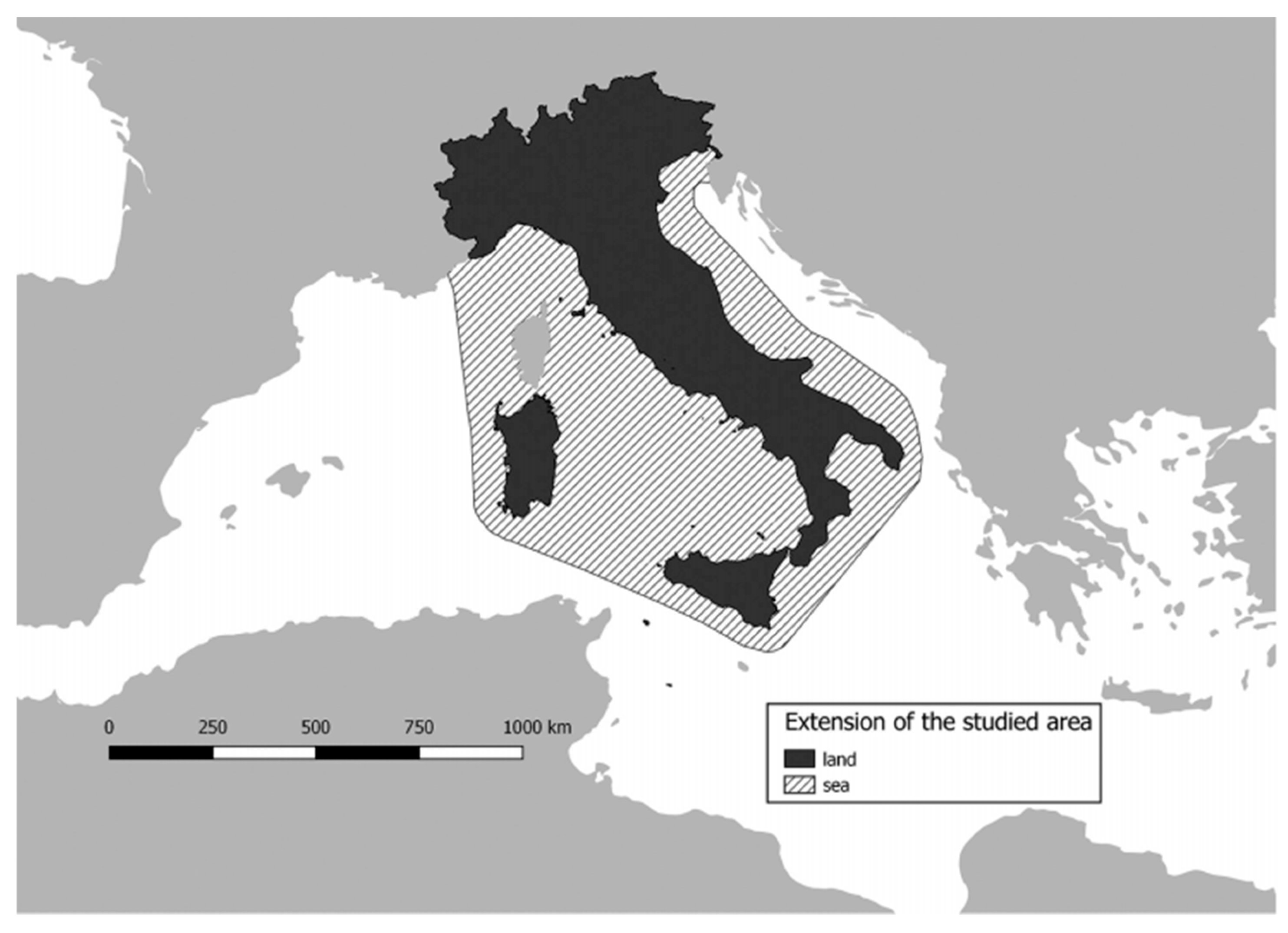
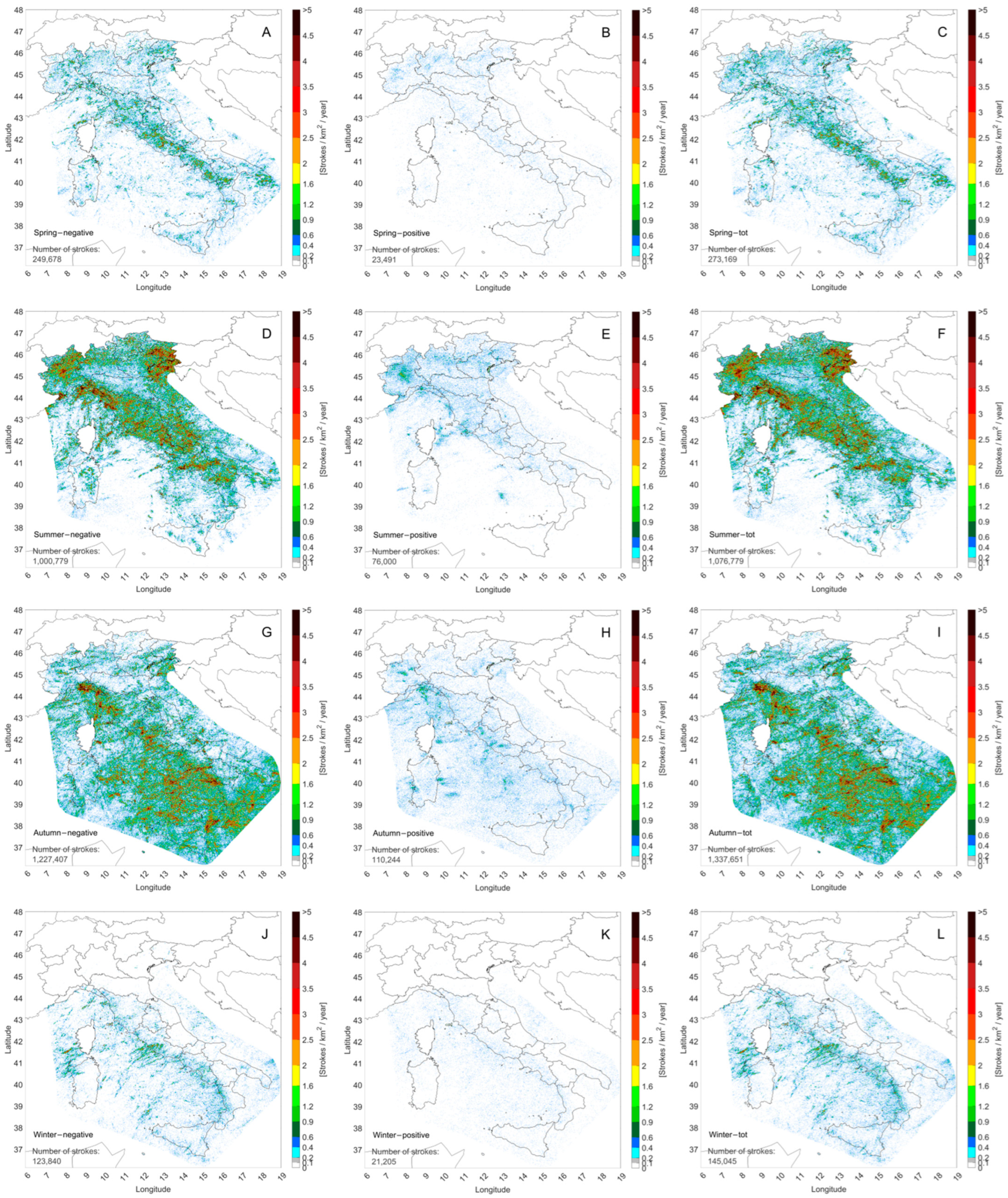
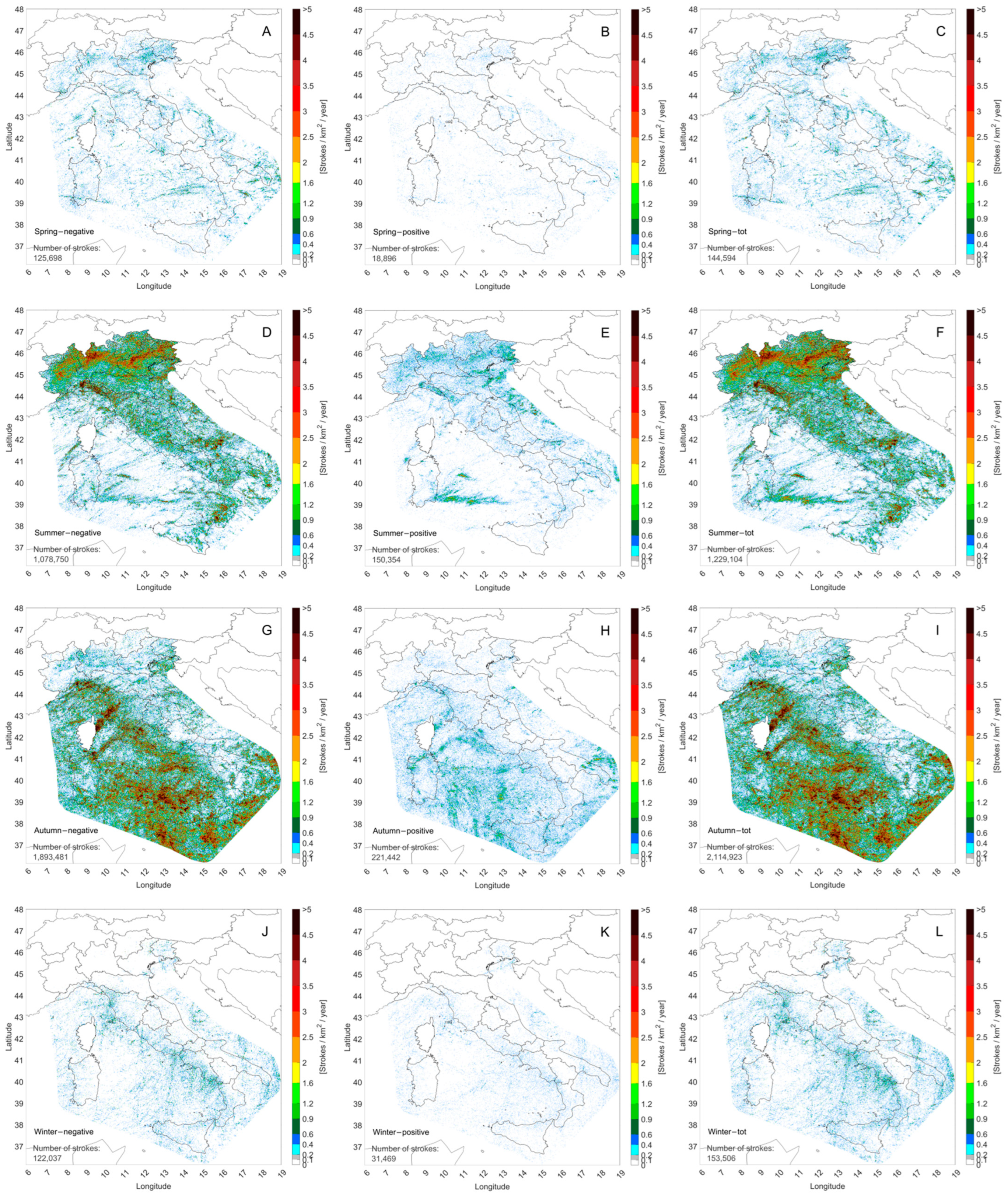
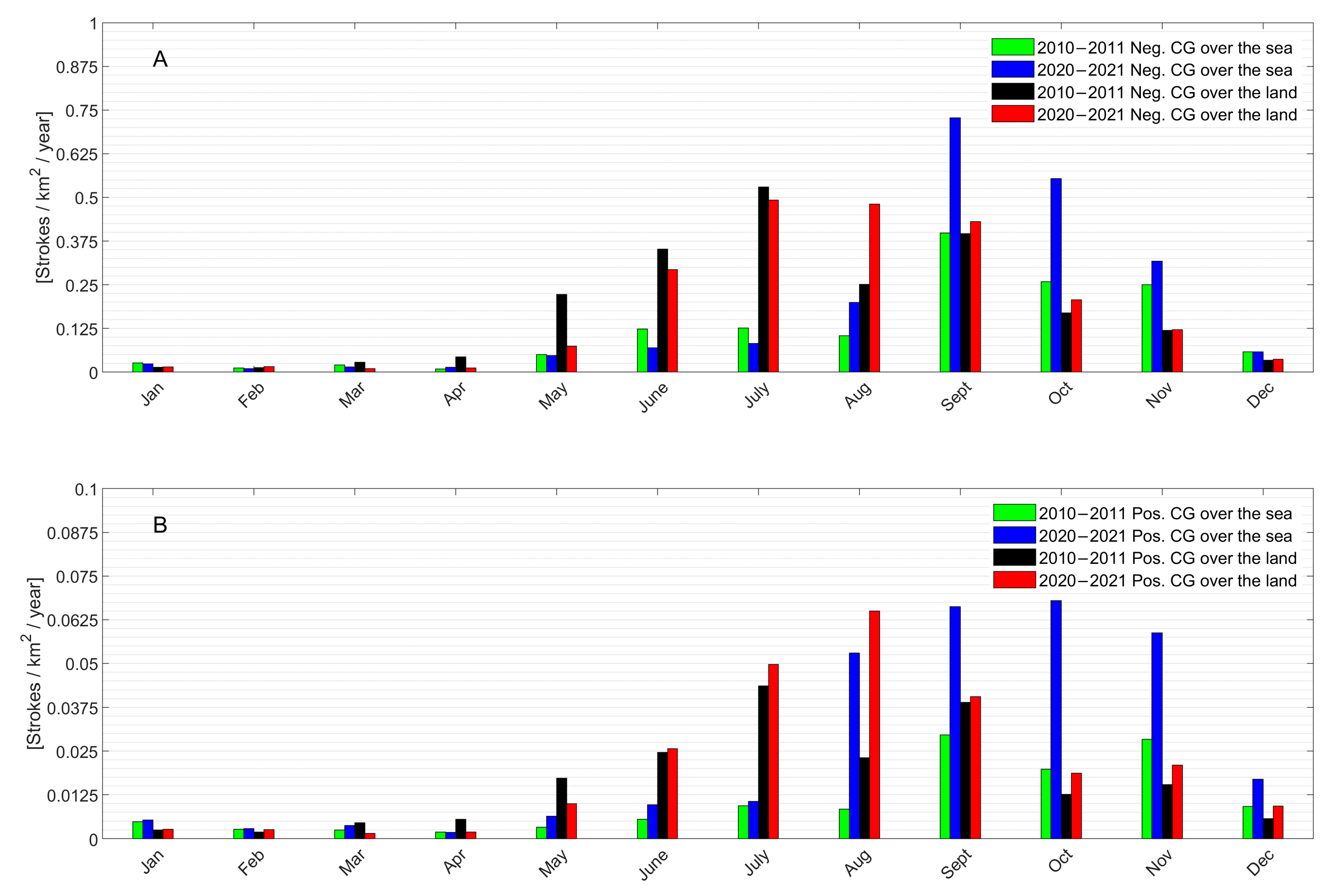

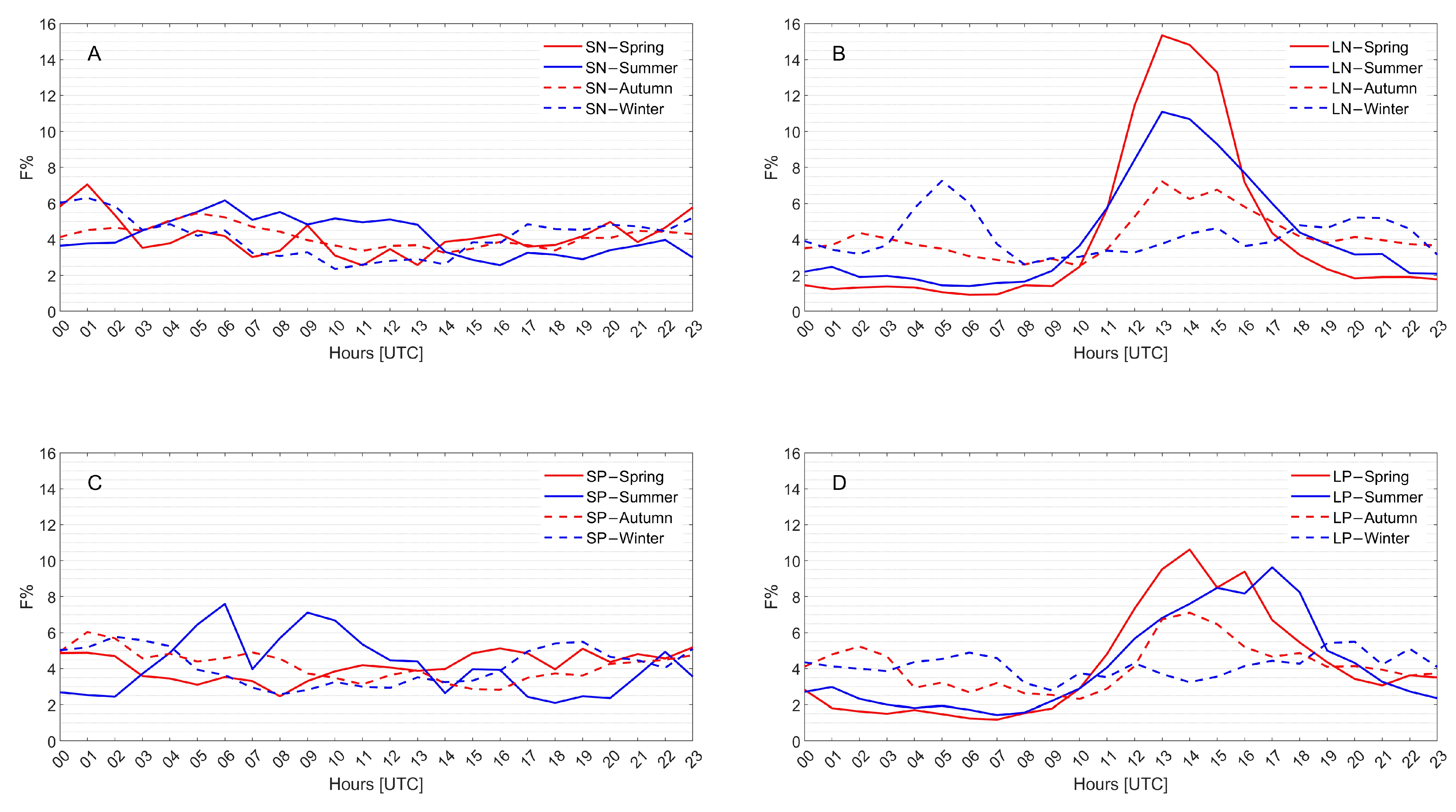

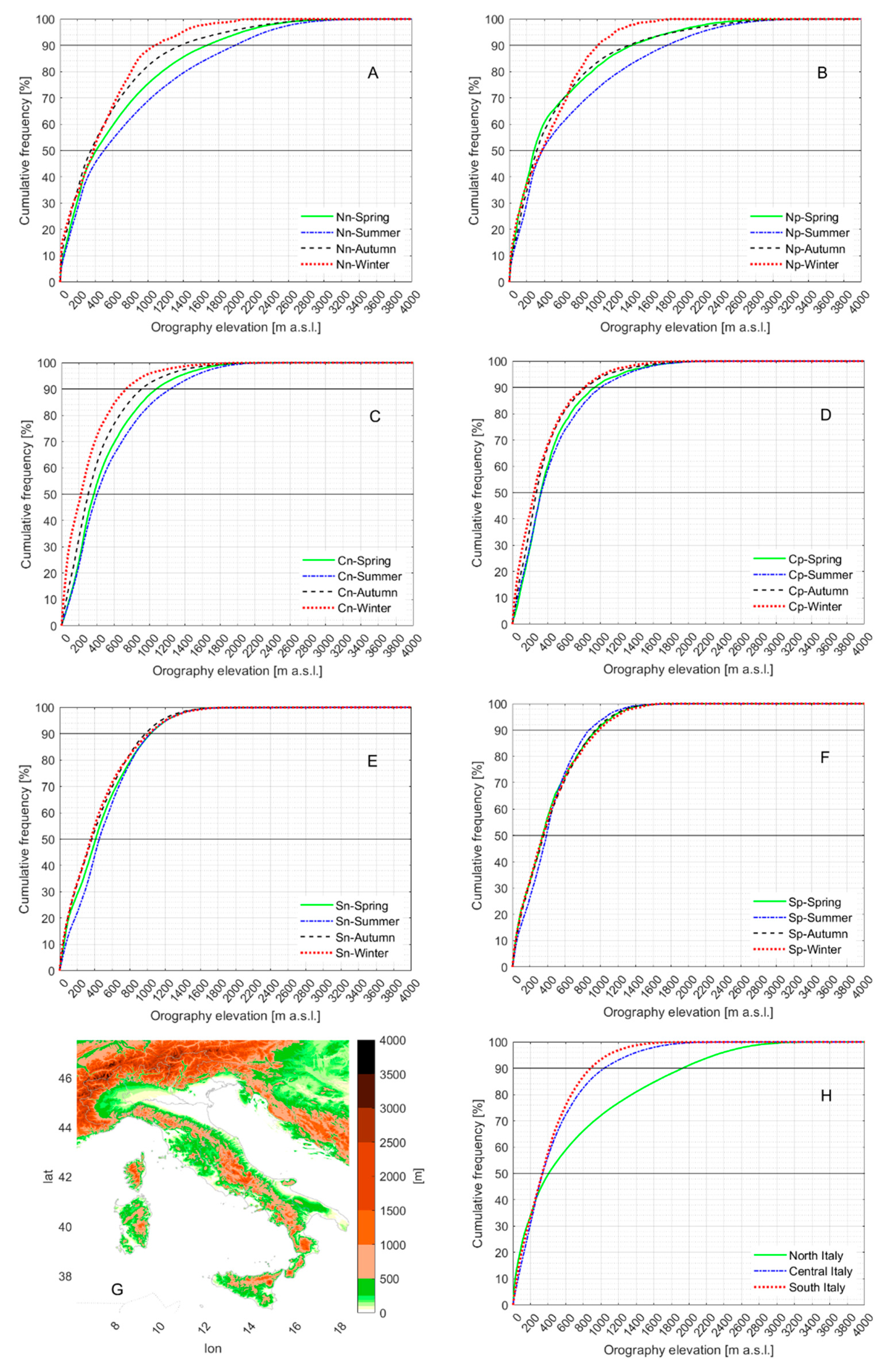
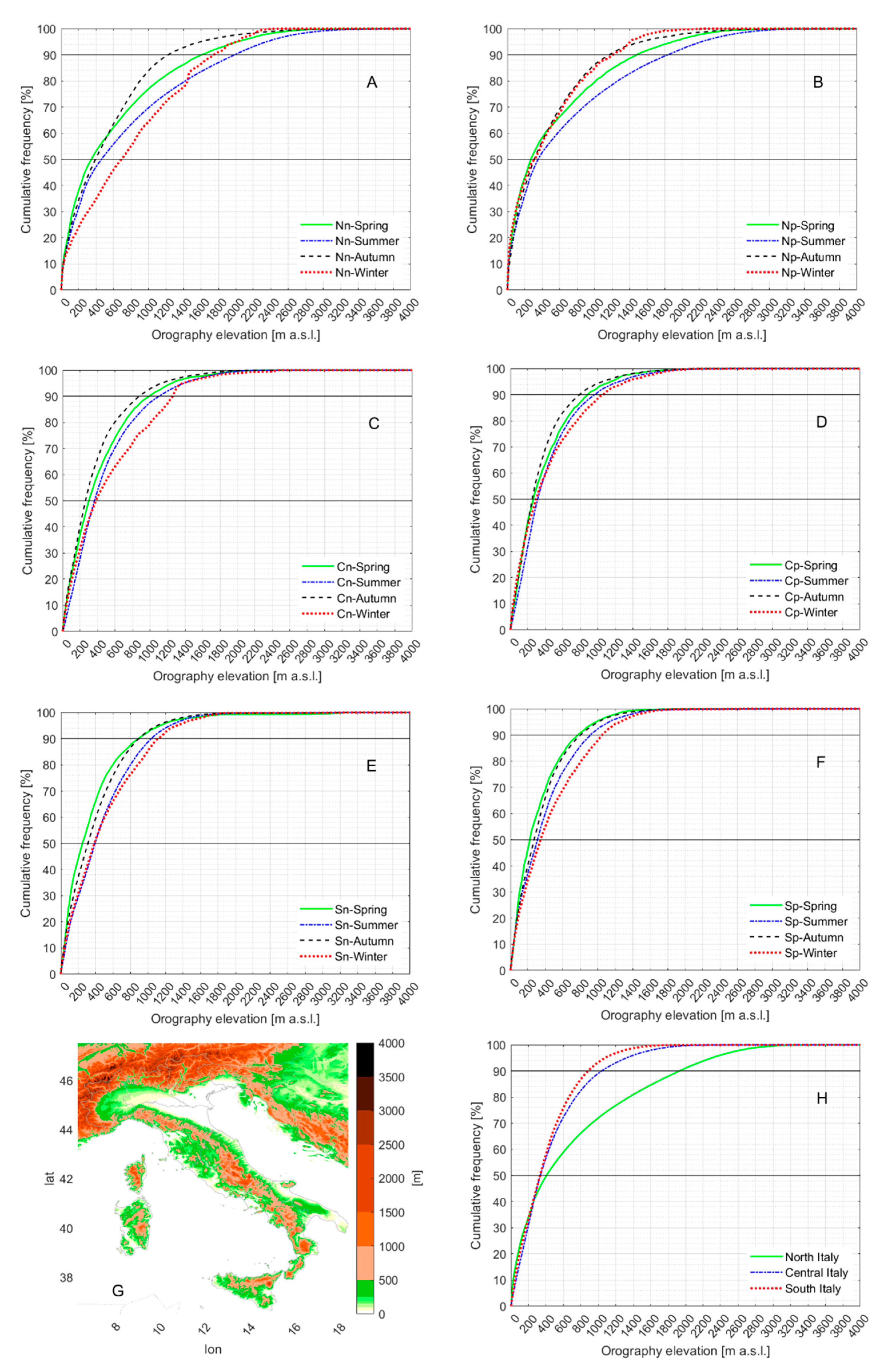
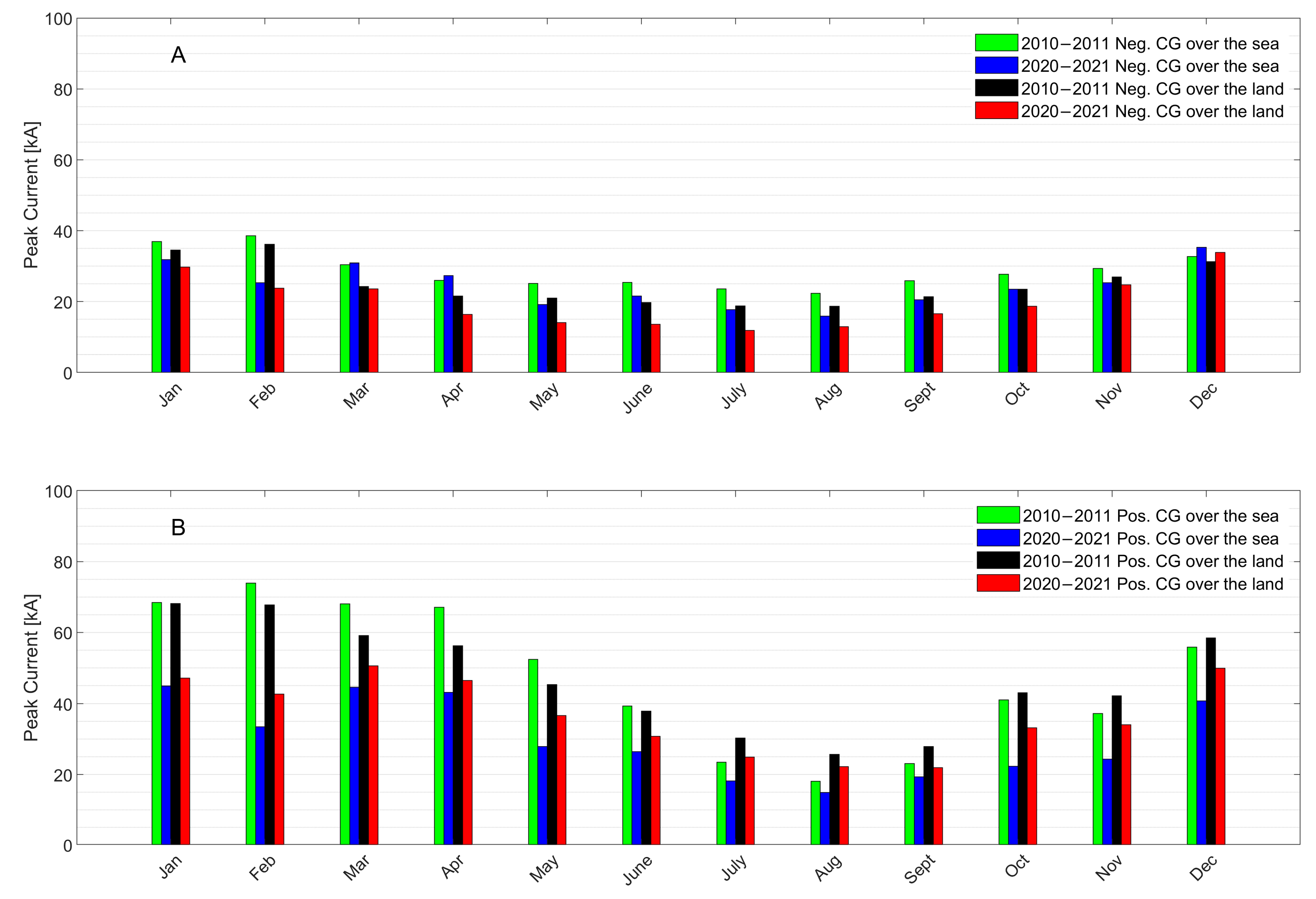
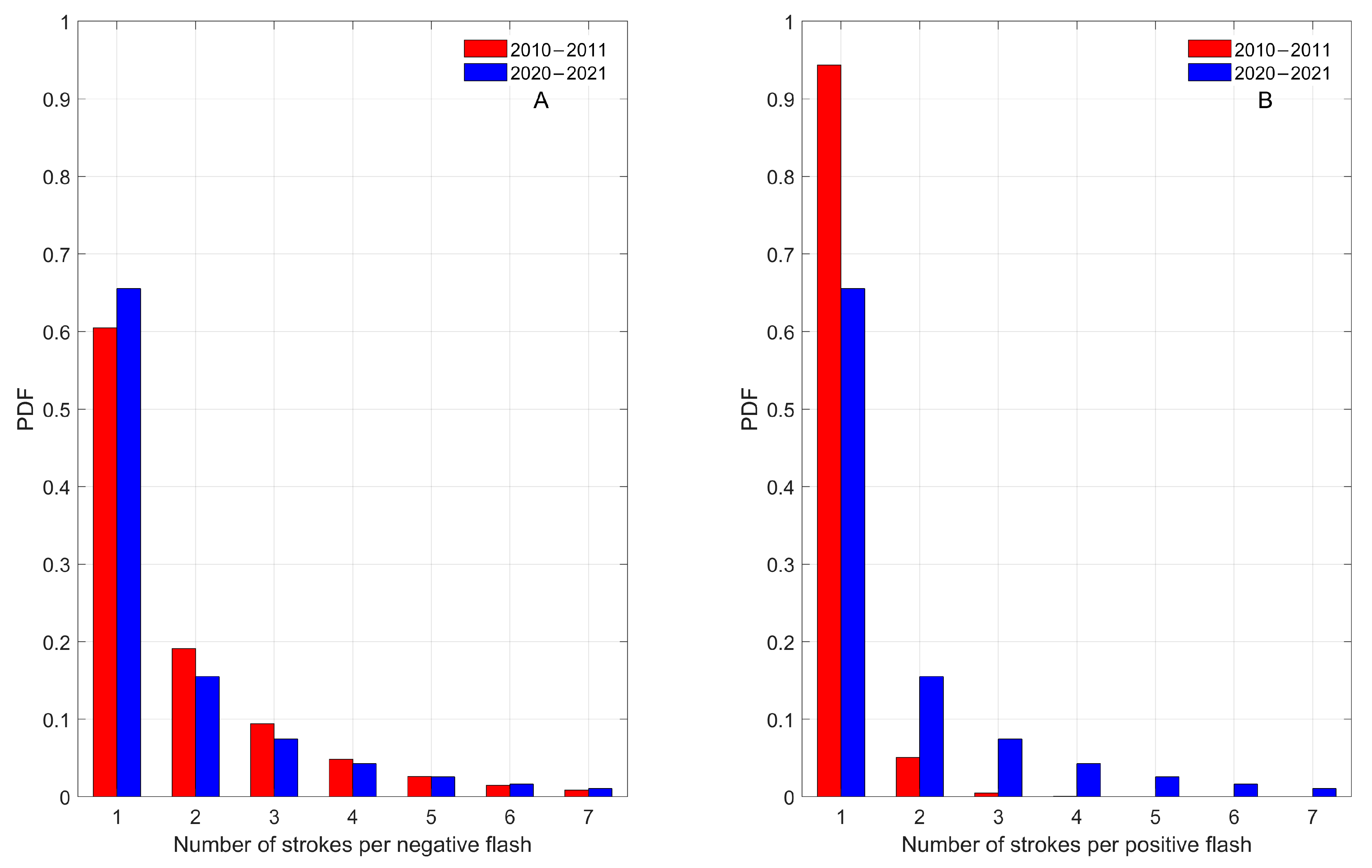
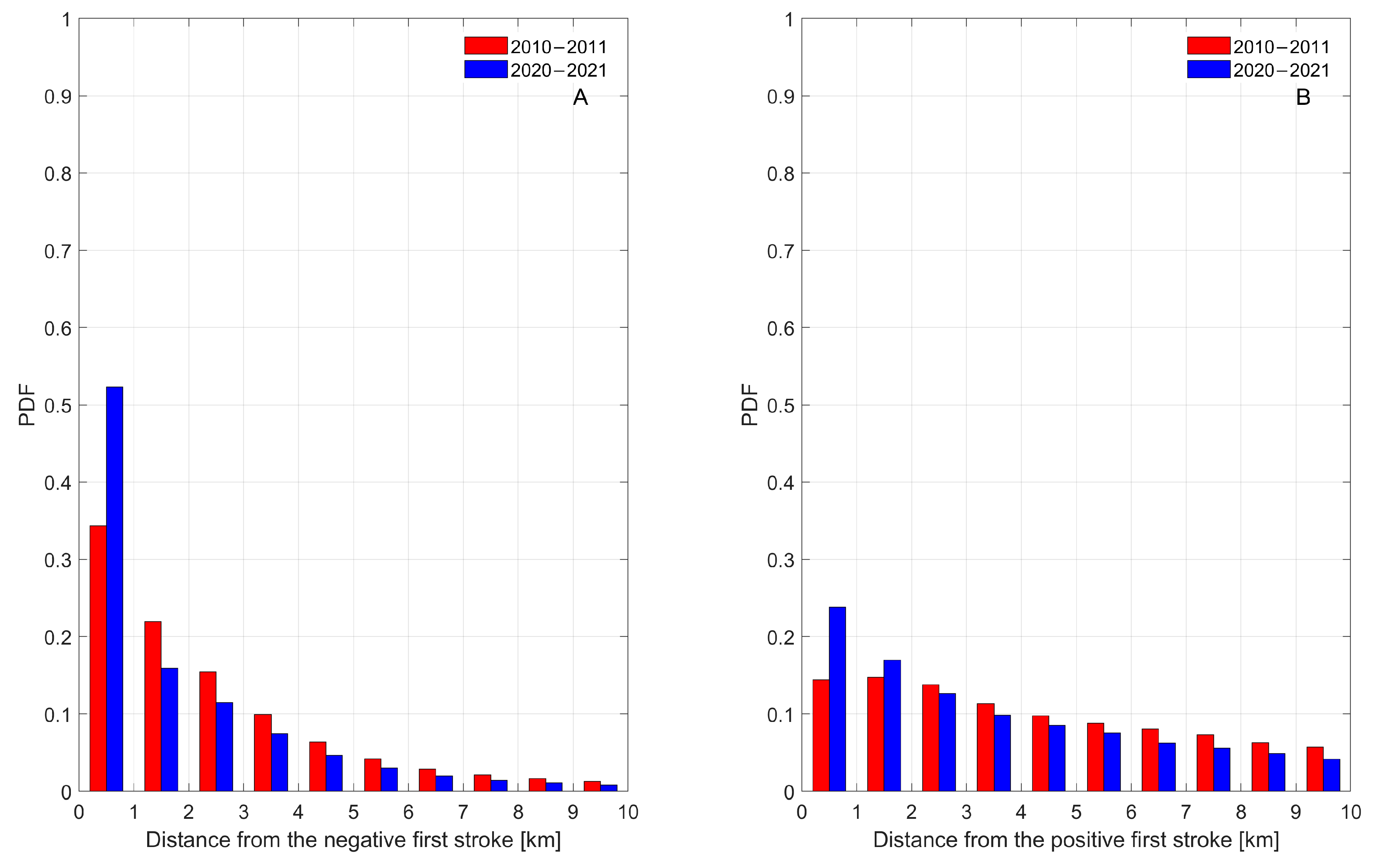
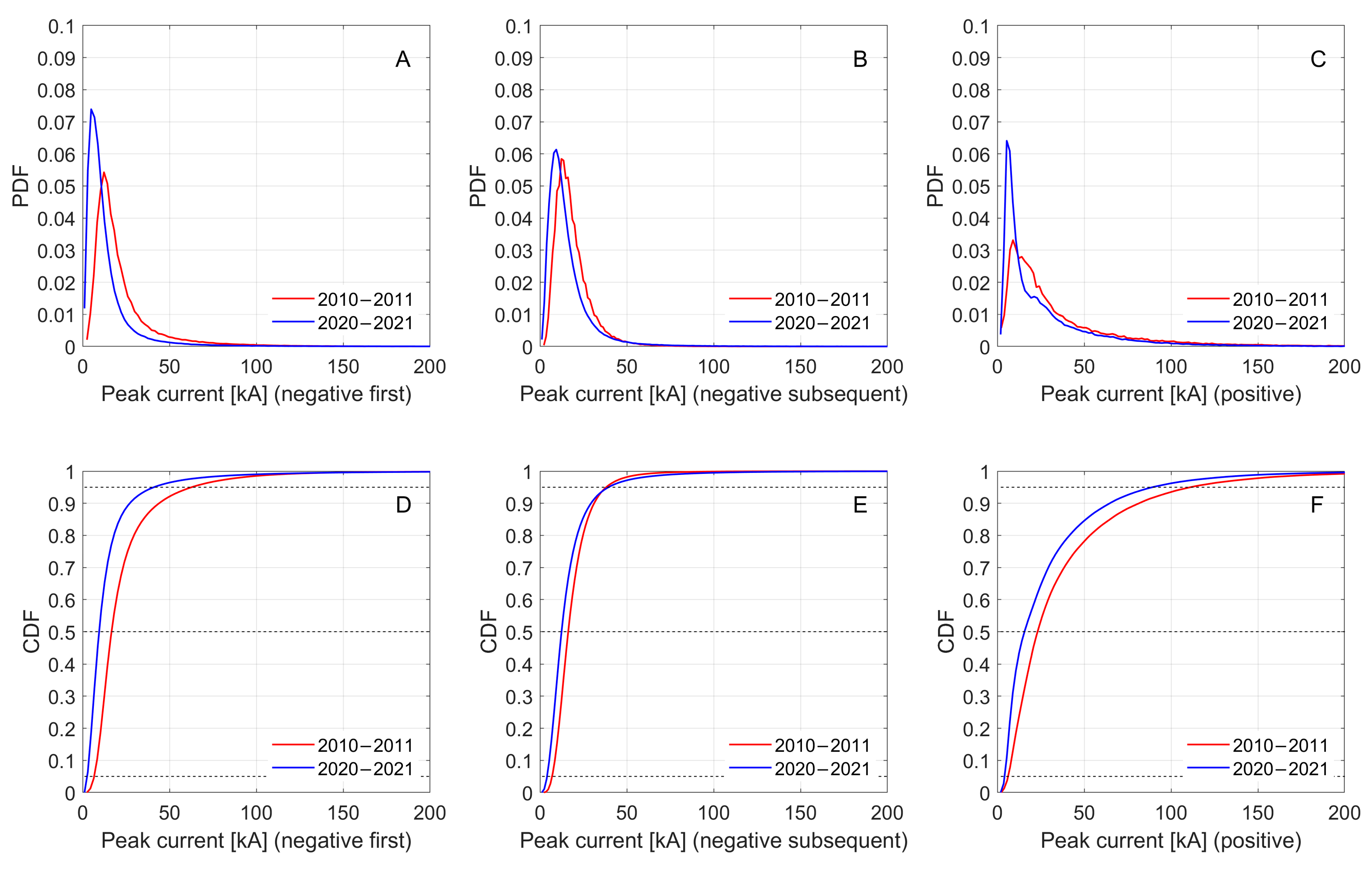
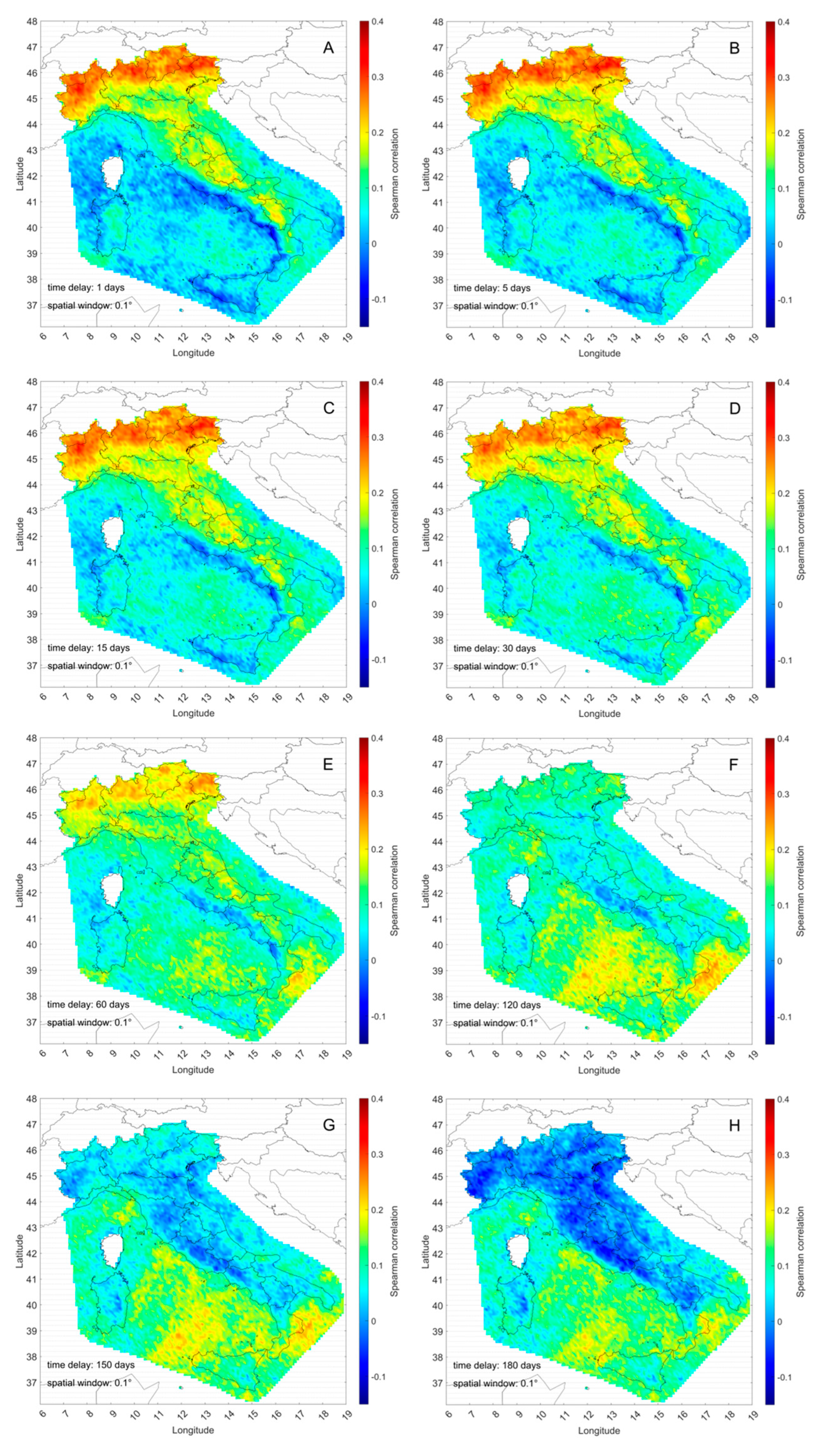
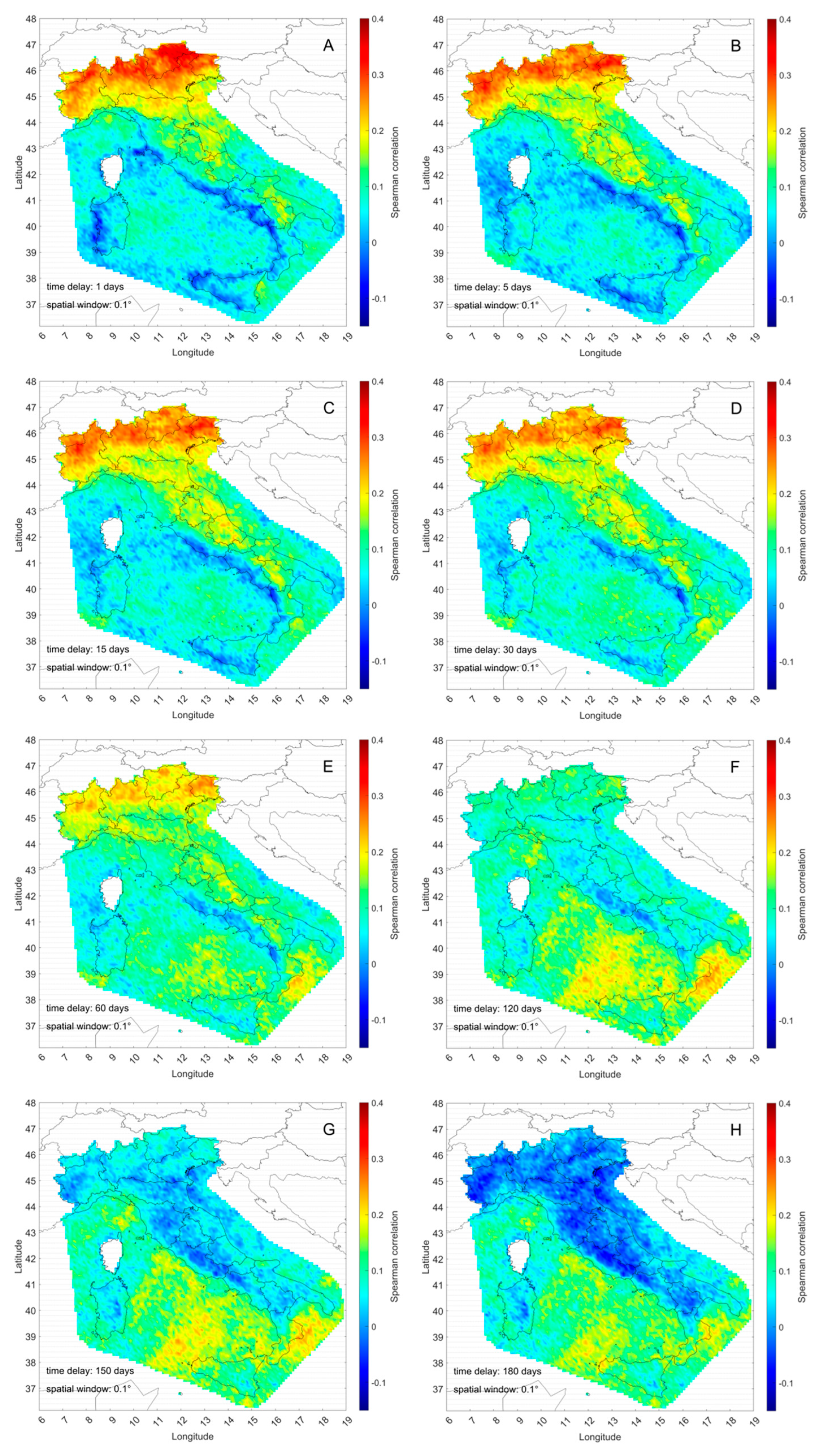
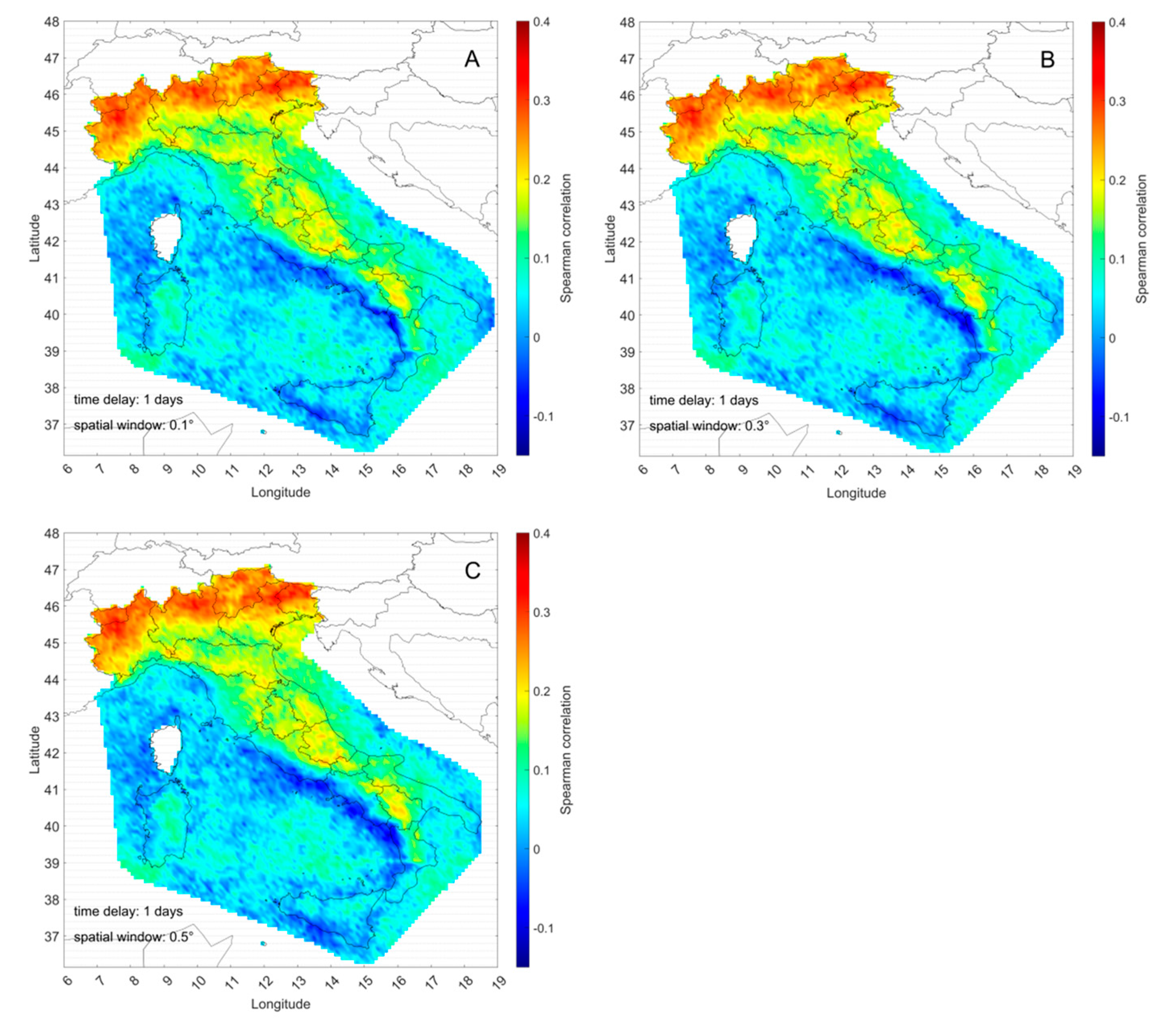
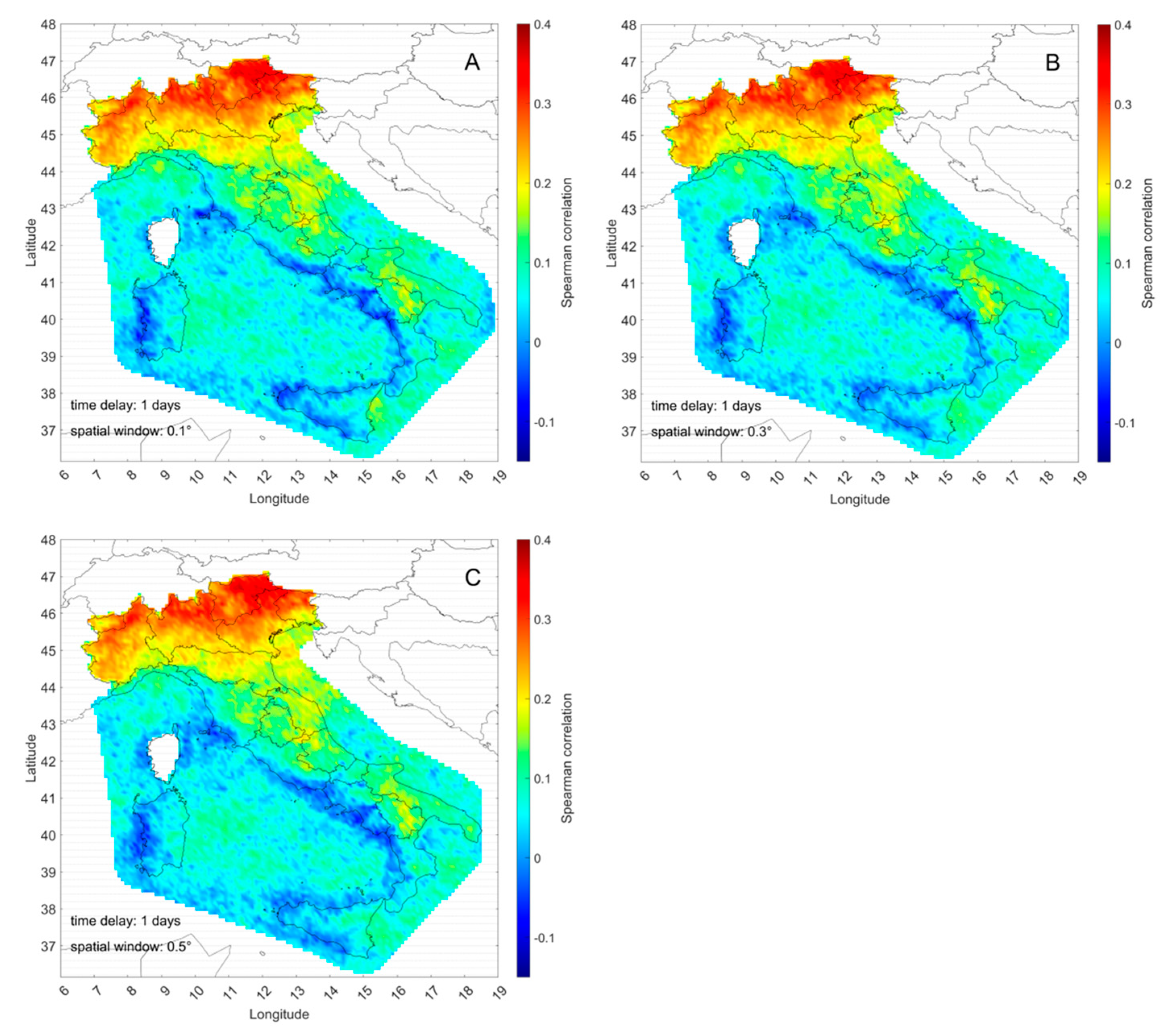
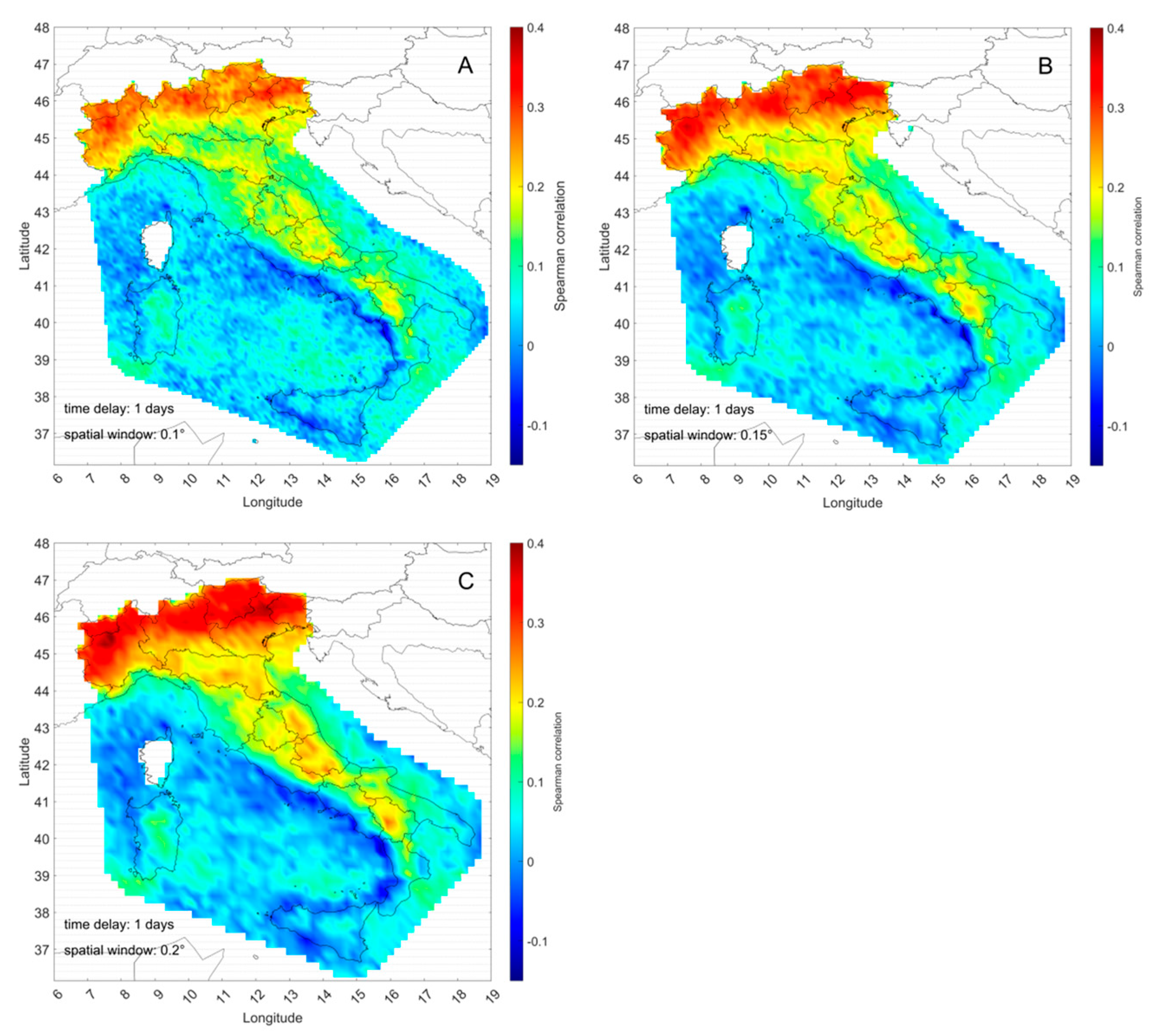
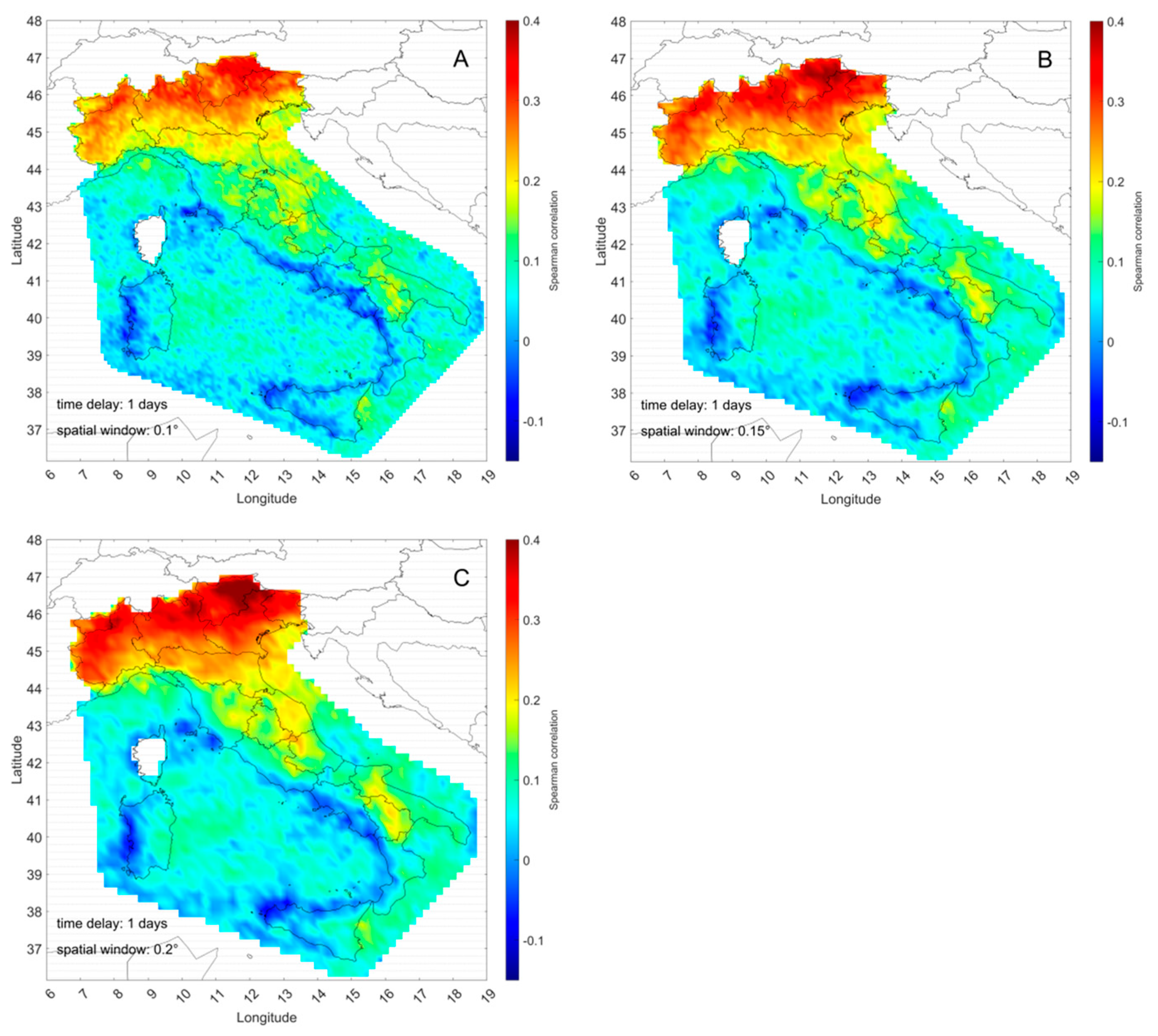


| 2010–2011 | 2020–2021 | Increment in 10 Years | |||||||
|---|---|---|---|---|---|---|---|---|---|
| Neg. | Pos. | Tot. | Neg. | Pos. | Tot. | Neg. | Pos. | Tot. | |
| Spring | 249,678 | 23,491 | 273,169 | 125,698 | 18,896 | 144,594 | −50% | −20% | −47% |
| Summer | 1,000,779 | 76,000 | 1,076,779 | 1,078,750 | 150,354 | 1,229,104 | 8% | 98% | 14% |
| Autumn | 1,227,407 | 110,244 | 1,337,651 | 1,893,481 | 221,442 | 2,114,923 | 54% | 101% | 58% |
| Winter | 123,840 | 21,205 | 145,045 | 122,037 | 31,469 | 153,506 | −1% | 48% | 6% |
| Tot. | 2,601,704 | 230,940 | 2,832,644 | 3,219,966 | 422,161 | 3,642,127 | 24% | 83% | 29% |
| Strokes | 5th Percentile | 50th Percentile | 90th Percentile |
|---|---|---|---|
| Negative first | 8.4 | 18.1 | 63.2 |
| Negative subsequent | 7.3 | 17.4 | 38.8 |
| Positive first | 7.3 | 24.1 | 111.7 |
| Strokes | 5th Percentile | 50th Percentile | 90th Percentile |
|---|---|---|---|
| Negative first | 3.0 | 10.7 | 41.4 |
| Negative subsequent | 5.2 | 13.5 | 39.7 |
| Positive first | 5.4 | 15.9 | 89.4 |
Disclaimer/Publisher’s Note: The statements, opinions and data contained in all publications are solely those of the individual author(s) and contributor(s) and not of MDPI and/or the editor(s). MDPI and/or the editor(s) disclaim responsibility for any injury to people or property resulting from any ideas, methods, instructions or products referred to in the content. |
© 2025 by the authors. Licensee MDPI, Basel, Switzerland. This article is an open access article distributed under the terms and conditions of the Creative Commons Attribution (CC BY) license (https://creativecommons.org/licenses/by/4.0/).
Share and Cite
Nicora, M.; Moura, R.A.R.; Bernardi, M.; Mestriner, D.; Fiori, E. Analysis of Ten-Year Variations of Lightning Activity in Italy and Correlation with Land and Sea Surface Temperatures. Appl. Sci. 2025, 15, 11038. https://doi.org/10.3390/app152011038
Nicora M, Moura RAR, Bernardi M, Mestriner D, Fiori E. Analysis of Ten-Year Variations of Lightning Activity in Italy and Correlation with Land and Sea Surface Temperatures. Applied Sciences. 2025; 15(20):11038. https://doi.org/10.3390/app152011038
Chicago/Turabian StyleNicora, Martino, Rodolfo Antonio Ribeiro Moura, Marina Bernardi, Daniele Mestriner, and Elisabetta Fiori. 2025. "Analysis of Ten-Year Variations of Lightning Activity in Italy and Correlation with Land and Sea Surface Temperatures" Applied Sciences 15, no. 20: 11038. https://doi.org/10.3390/app152011038
APA StyleNicora, M., Moura, R. A. R., Bernardi, M., Mestriner, D., & Fiori, E. (2025). Analysis of Ten-Year Variations of Lightning Activity in Italy and Correlation with Land and Sea Surface Temperatures. Applied Sciences, 15(20), 11038. https://doi.org/10.3390/app152011038









